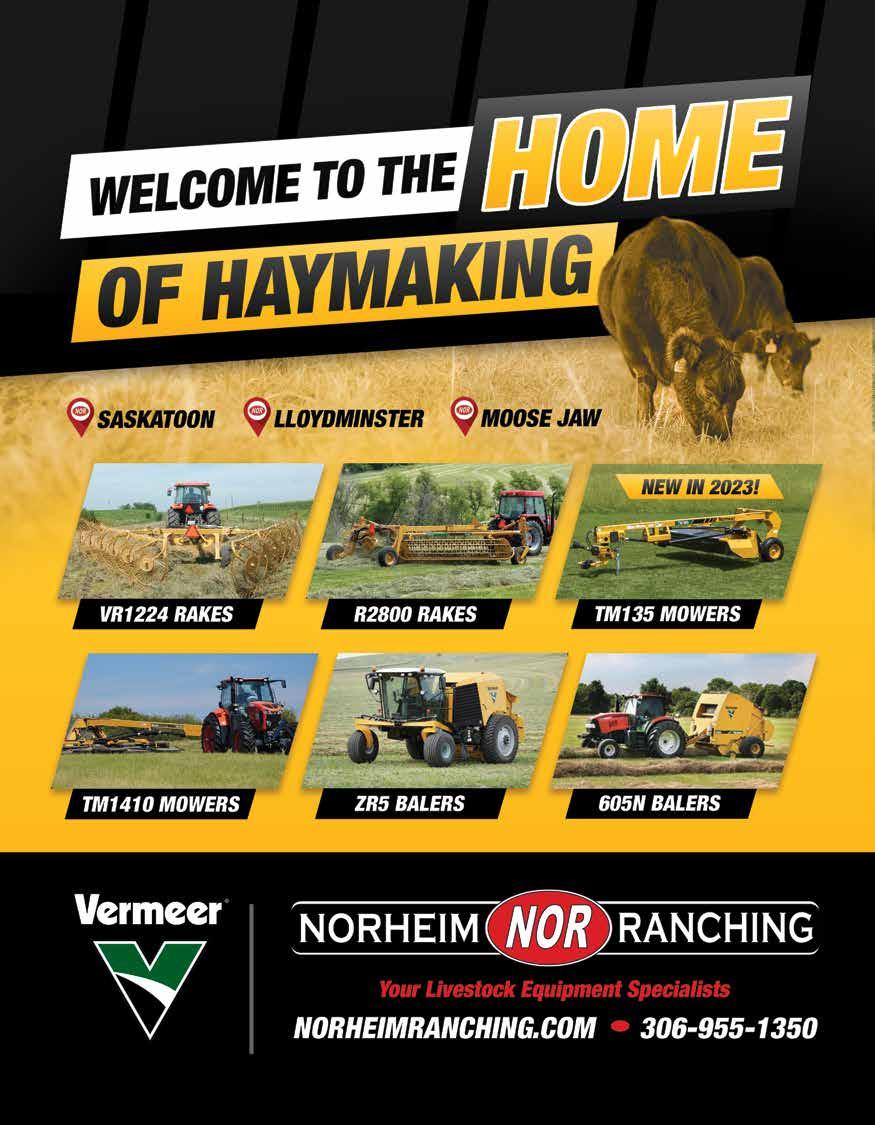






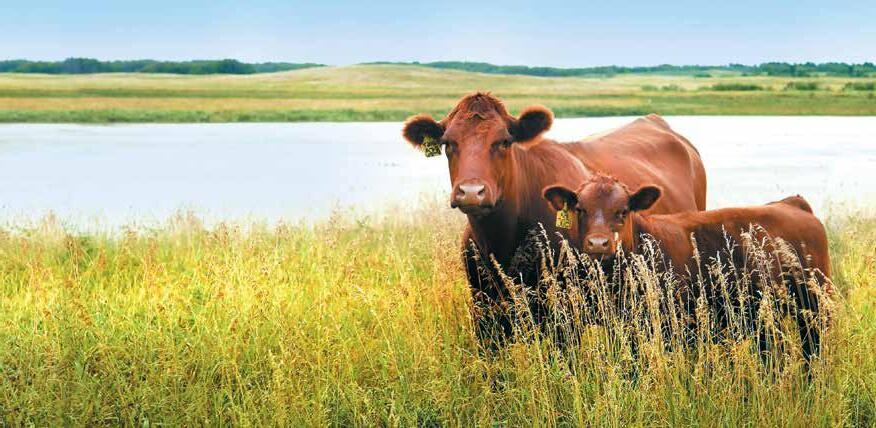
Across the working landscapes of Saskatchewan, the wetlands and grasslands needed by wildlife are owned and sustainably managed by ranchers like you.
As beef producers, you protect our province’s most important natural areas. Ducks Unlimited Canada (DUC) understands that a prosperous beef industry is central to healthy land, vibrant rural communities and abundant wildlife populations. We offer farmgate conservation programs designed to support your stewardship efforts and put money back in your pocket.
Z Need more livestock feed? DUC’s Forage Program pays $100/acre for field-scale conversion to perennial forage. Additional program incentives could take that to $200/acre.
Z Have land with water and grass? DUC’s Rangeland Program pays up to $5,000 to protect grasslands and existing wetlands for a 10-year term.
Z Conservation Easements (CEs) protect your land’s natural values in perpetuity, pay up to 35% of current land values, and have no restrictions on haying or grazing.
Z DUC’s Revolving Lands Program (RLP) can be a cost-effective option to expand your land holdings. RLP lands have been restored to tame grassland; since a CE is a condition of purchase, these lands sell for slightly below fair market value. There are no restrictions on haying or grazing.
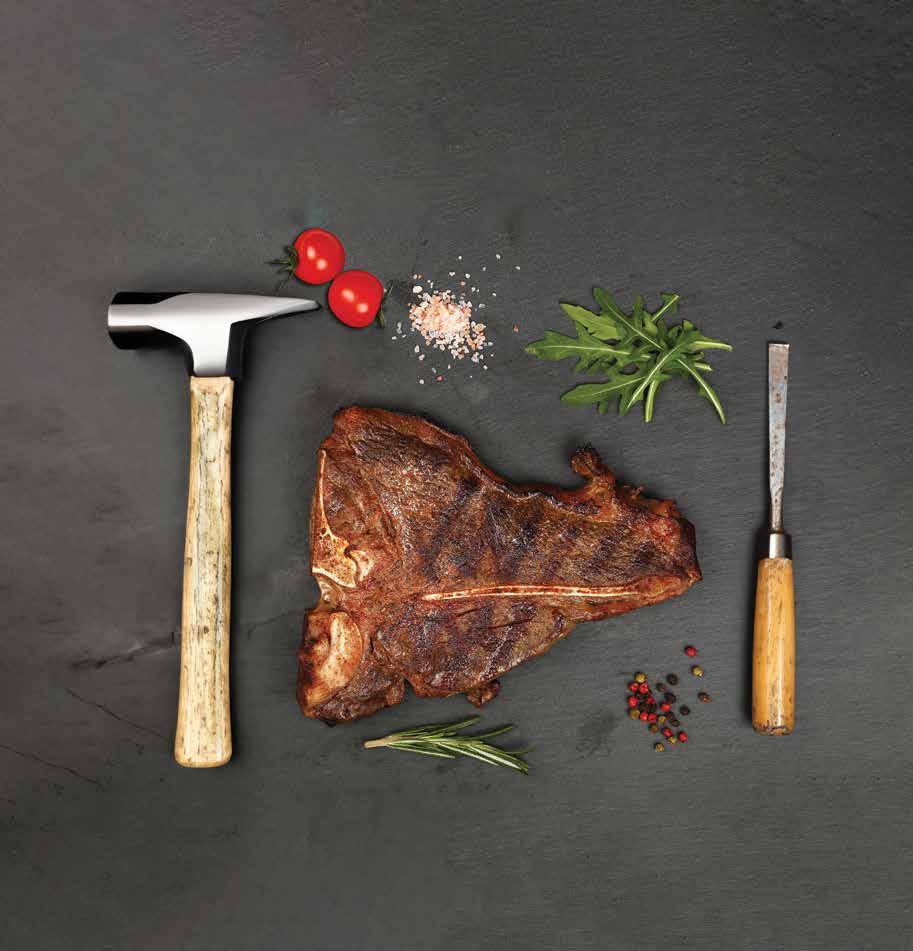
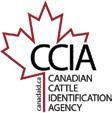

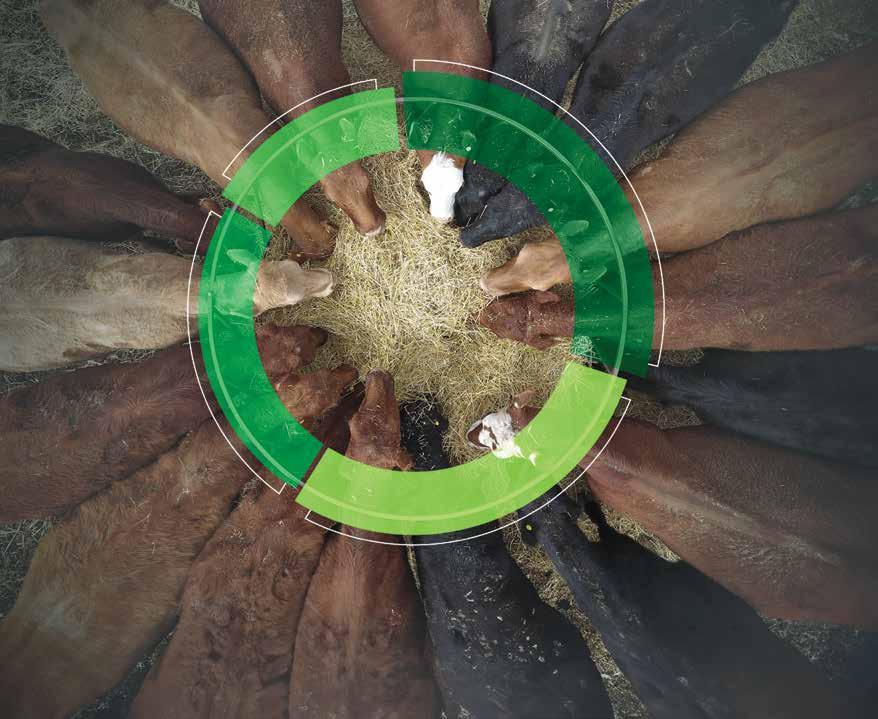
As a livestock producer, you want more than just insurance for your operation. You want complete, 360° coverage. The kind of all-around coverage you can only get from SCIC. With weather-based coverage for forage acres, price protection for livestock and personalized coverage options, SCIC offers a full suite of programs that can work together to ensure you have every angle covered!
From Crop Insurance, to AgriStability, to Livestock Price Insurance, we’re here to help you find the right coverage for your farm.
Let’s chat! Call 1-888-935-0000 or contact your local SCIC office today.
scic.ca/find-your-right-coverage
A Saskatchewan Stock Growers Association (SSGA) Publication
General Manager: Chad MacPherson
Box 4752, Evraz Place, Regina, SK S4P 3Y4
Tel: 306-757-8523 Fax: 306-569-8799
Email: gm@skstockgrowers.com
Website: www.skstockgrowers.com
Managing Editor: Kori Maki-Adair
Tel: 403-680-5239 Email: kmaa@shaw.ca
Agri-business Advertising Sales: Diane Sawatzky
Tel: 306-716-4271 Email: sales@skstockgrowers.com
Livestock Advertising Sales: Stephanie Kot
Tel: 306-861-4348 Email: livestocksales@skstockgrowers.com
Subscriptions
Box 4752, Evraz Place, Regina, SK S4P 3Y4
Tel: 306-757-8523 Fax: 306-569-8799
Email: office@skstockgrowers.com
Subscription Rate: One year $26.50 (GST included) Published five times per year
Design and Layout: Jackson Designs | Candace Schwartz
Tel: 306-772-0376 Email: candace@jacksondesigns.ca
Prairie Conservation Action Plan (PCAP)
Manager: Carolyn Gaudet
Box 4752, Evraz Place, Regina, SK S4P 3Y4
Tel: 306-352-0472 Fax: 306-569-8799
Email: pcap@sasktel.net
SSGA reserves the right to refuse advertising and edit manuscripts. Contents of Beef Business may be reproduced with written permission obtained from SSGA's General Manager, and with proper credit given to Saskatchewan Stock Growers Association. Articles submitted may not be the opinion of SSGA. SSGA assumes no responsibility for any actions or decisions taken by any reader from this publication based on any and all information provided.
Publications Mail Agreement #40011906
Return undeliverable Canadian addresses (covers only) to: Saskatchewan Stock Growers Association Box 4752, Evraz Place, Regina, SK S4P 3Y4
•
•
•
•
•
•
•
•
•
•
•
•
•
•
•
•
•
•
Terry Bedard
Beneficial management practices, or BMPs, are agricultural procedures that ensure the long-term health and sustainability of agricultural land, positively impact the long-term economic and environmental viability of agricultural production, or minimize negative impacts and risk to the environment. Statistics Canada conducted a “Survey on Local Food and Beneficial Management Practices” in March and April of 2023; a look at some of their findings is below.
One of the practices examined was rotational grazing. From the survey, it was estimated that rotational grazing was practiced on 5.6 million acres of pastureland in Saskatchewan in 2022. Saskatchewan, in fact, leads the country in the number of pasture acres under rotational grazing at 41.2 per cent, followed by Alberta with 32.6 per cent.
Respondents were asked the average cost per agricultural operation to practice rotational grazing on pasture land, excluding upfront costs. The average cost across all farm types in Canada was $3,730. Manitoba, Saskatchewan and British Columbia all had costs higher than the national average. For Saskatchewan, the average cost was estimated at $4,123, second only to Manitoba at $6,333.
Respondents were also asked the main reasons for their agricultural operations to practice rotational grazing. Across all farm types in Saskatchewan, the top reason, at 44.6 per cent, was the confidence that rotational grazing could be practiced successfully by their operation. The second reason (38.6 per cent) was that anticipated financial benefits would be
greater than the costs, and the third reason (38.0 per cent) was to meet an on-farm conservation need. The reasons least cited include the operation receiving technical or financial assistance as well as doing it to meet consumer preferences.
Livestock information was also released from the Farm Management Survey, a collaborative project between Statistics Canada and Agriculture and Agri-Food Canada. The Farm Management Survey is conducted every five years and uses a sample selected to be representative of 81.0 per cent of Canada’s production of each of the sectors it surveys.
The first table released was about the use and content of a prevention-focused health program for livestock operations. While 100.0 per cent of the livestock producers surveyed indicated they had a prevention-focused health program for their livestock, less than two-thirds (63.0 per cent) indicated the program was professionally-developed for the livestock.
The 100.0 per cent survey result applied to all livestock types in the province and likely increased to that number when legislation came into place requiring a veterinarian relationship before being able to purchase some animal health drugs their livestock might need. All operations indicated veterinarian relationships were in place, and all but 17.0 per cent indicated the veterinarian has examined or is knowledgeable of their livestock.
So, what types of things are included in these Saskatchewan prevention-focused health plans? The number-one item reported (96.0 per cent) was a vaccination
program. Other items included parasite control (85.0 per cent), breeding soundness examinations (80.0 per cent), management of painful procedures (56.0 per cent), ration development and supplementation (48.0 per cent), and biosecurity measures (38.0 per cent).
Sixty-three per cent of beef producers indicated they had a professionallydeveloped, prevention-focused health program with 93.0 per cent of dairy producers reporting the same. A higher percentage of dairy farms than beef farms reported having biosecurity measures, ration development and supplementation, and management of painful procedures in their health plans, while a higher percentage of beef farms than dairy farms reported having vaccination, parasite control, and breeding soundness examinations in their health plans.
Livestock producers were also asked about manure management practices.
In 2021, 45.0 per cent of Saskatchewan beef producers used practices to manage or treat solid manure, down from 48.0 per cent in 2017. The main practice used was to turn or mix, occasionally, to encourage partial decomposition. Regarding manure storage, 23.0 per cent said they stored it in piles in the farmyard, down from 31.0 per cent in 2017. Twenty-two per cent indicated they had storage piles in fields or at the edges of fields, up from 17.0 per cent in 2017.
Next issue, we will take a look at the results for winter and summer grazing in the Farm Management Survey. B
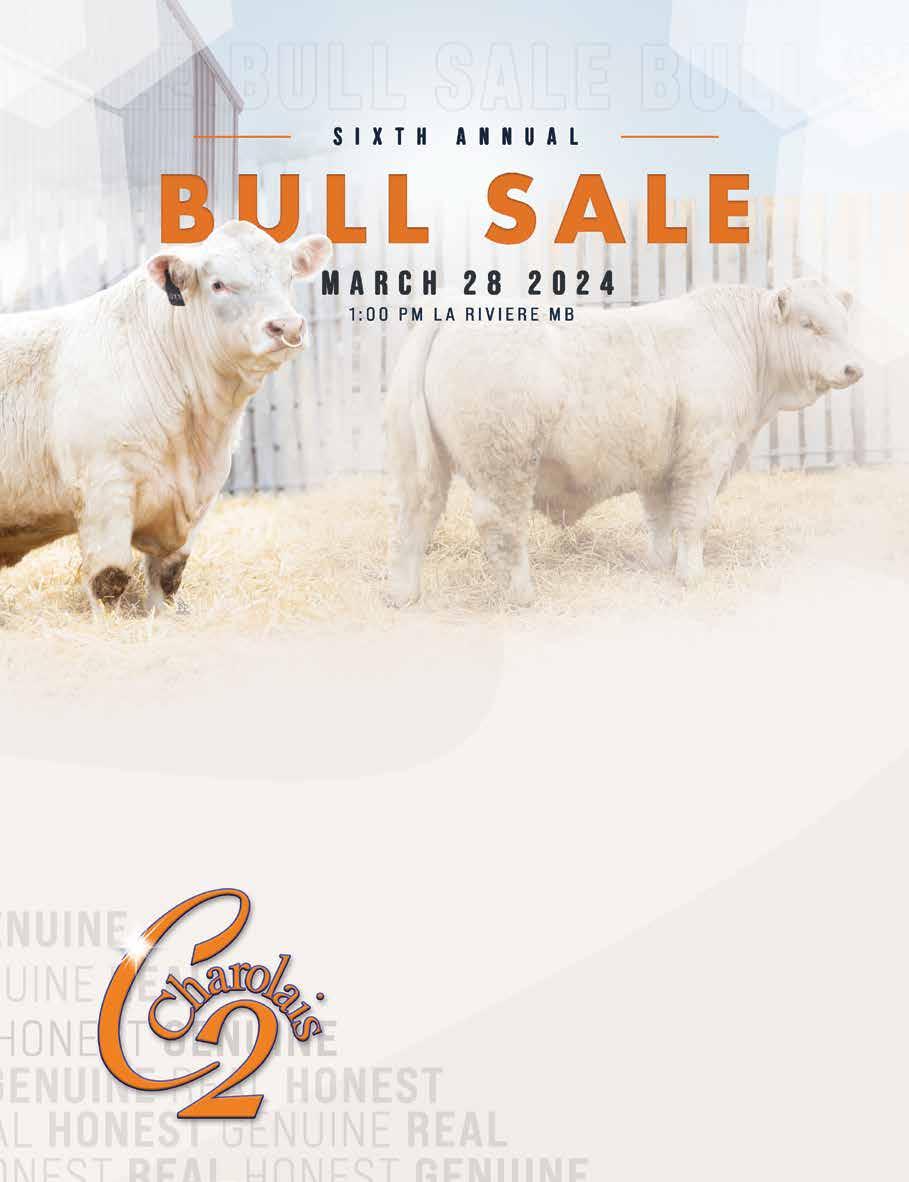
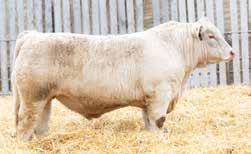


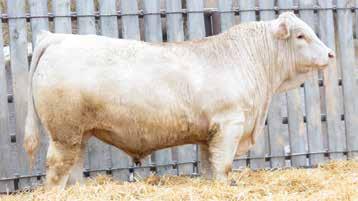
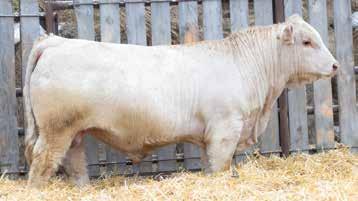


Greatly responsible for Canada’s food security, while preserving biodiversity and contributing to carbon sequestration in soils and biomass, Saskatchewan beef producers are always looking for ways to improve the sustainability of their livestock operations.
And although scientists claim that burning fossil fuels (for electric power, transportation and heat), is the world’s largest source of greenhouse gas (GHG) emissions, the Food and Agriculture Organization (FAO) of the United Nations reported that agriculture and related landuse emissions account for approximately 17 per cent of global GHGs in a global emissions briefing released in 2018.1
That’s not a small number, but there is good news in that briefing. It also indicates ag-related GHGs dropped seven per cent between the 2000s and 2018 due to innovations in on-farm practices.
While the FAO released that information more than five years ago, a seven per cent reduction in GHGs over a decade and a half is remarkable considering the world’s population grew by more than a billion in that time. 2
Now exceeding eight billion people, the world relies on ag producers to feed its population while reducing agrelated GHGs. To meet those immense expectations, ag producers need help.
Fortunately in February, two global animal health pathfinders announced newlyapproved products and tools designed to do exactly that in feedlots.
Elanco Animal Health began marketing the science-based efficacy of two feed additives and a web portal tool while DSM-Firmenich announced a pioneering feed ingredient and an emissions calculator app.
The first of Elanco’s products is Experior™—a new feed additive that is also the first to be approved by the United
States Food and Drug Administration (FDA) for the reduction of ammonia gas emissions from cattle and their waste (i.e., per pound of live weight and hot carcass weight in beef steers and heifers fed in confinement for slaughter during the last 14 to 91 days on feed). 3
Elanco’s second product is Rumensin®—a feed additive that’s been in use for more than a quarter century. While some producers have been using it for improved reproductive performance in heifers and improved weight gain in growing cattle on pasture, backgrounders and feedlots have also been using this additive for improved feed efficiency and preventing coccidiosis, a gut-damaging infection that most commonly affects young growing stock. However, Elanco relaunched Rumensin’s marketing profile last month after more than 400 Elanco research studies showed the product also reduces methane from beef cattle by 20 per cent.4
On the tech side, Elanco also announced its plans to bring UpLook™ to Canada this year. UpLook is an insights engine Elanco developed using more than 20 years of data from its Knowledge Solutions web portal setup for beef and dairy cattle, pigs, poultry and third-party industry stakeholders. Elanco’s Knowledge Solution portal allows users to upload data, which Elanco validates and turns into reporting materials that deliver business insights.
This portal’s UpLook tool utilizes a producer’s on-farm data and peerreviewed science to calculate the user’s carbon footprint, then sends that user regular reports on the key drivers of their operation’s GHG emissions. With that information in hand, the user can track the progress of their sustainability efforts and GHG emission reductions. As soon as Canadian producers have access to this tool, they will be able to submit those emission reduction reports as sciencebased receipts to monetize carbon credits.
Enter Elanco Animal Health’s licensed partner.
Canada’s Greenhouse Gas Offset Credit System encourages municipalities, Indigenous communities, foresters, farmers and other project developers to undertake innovative projects that reduce GHGs compared to business-as-usual practices.
Proponents of offset projects can generate federal offset credits if they register and implement projects meeting requirements in the Canadian Greenhouse Gas Offset Credit System Regulations and an applicable federal offset protocol.
Offset credits are tradable units representing verified GHG reductions achieved by a project either by reducing GHG emissions or increasing GHG removals from the atmosphere. Each offset credit is equivalent to one tonne of carbon dioxide reduced or removed from the atmosphere.
Federal offset credits can be sold and used for compliance by facilities covered in the federal Output-Based Pricing System or sold and used by others who are looking to meet voluntary climate targets or commitments.
After 15 years of purpose-led research that included more than one hundred trials across North America, Europe, Latin America and Oceania, including a two-year project in Alberta that involved 15,000 growing animals (not lactating animals), DSM-Firmenich received approval in Canada for Bovaer®—a proven solution for reducing enteric methane in animals. Already in use in 58 countries worldwide, a quarter teaspoon of Bovaer in an
continued on page 10
Jared
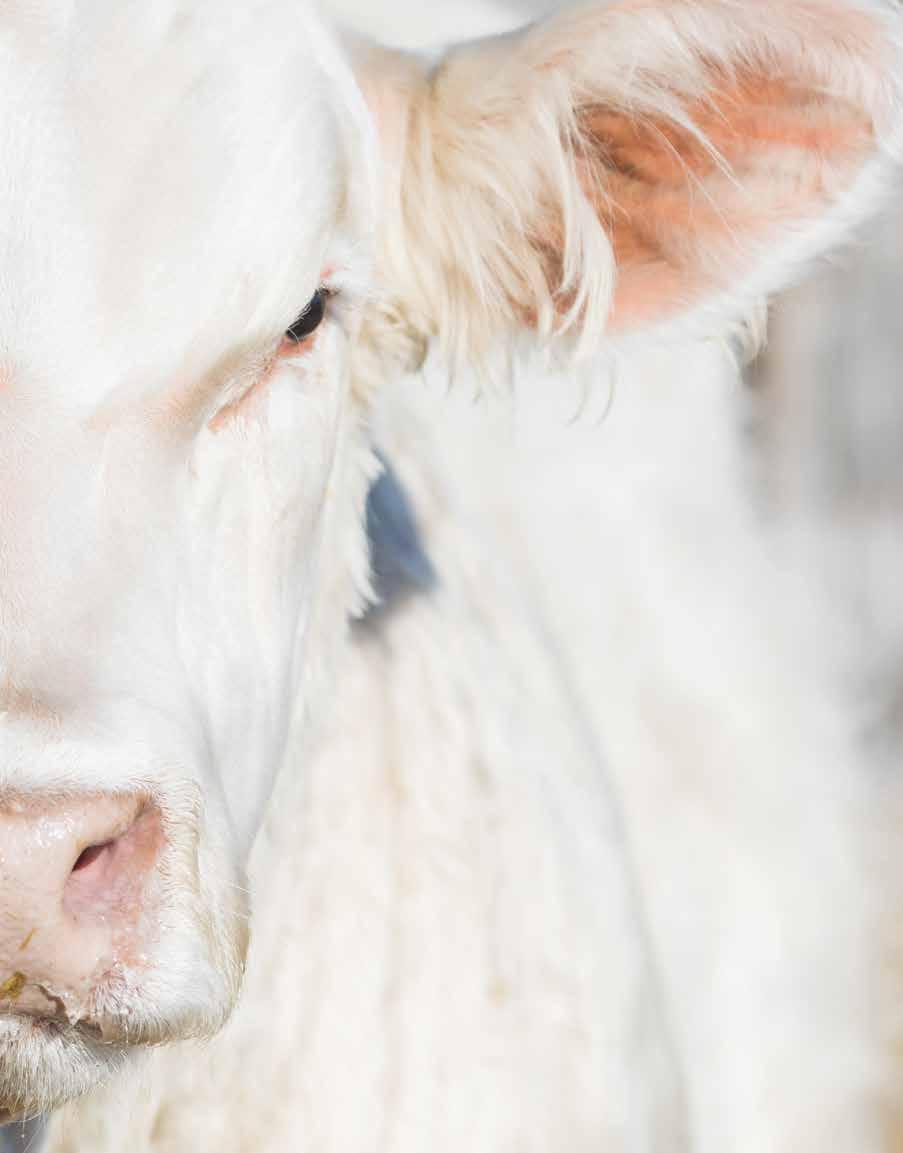
306-435-4925 Home
306-435-9842 Cell






animal’s feed ration reduces methane by approximately 45 per cent in beef cattle. 5
Emission Reduction Tools cont. from pg. 8 B
Since the enzymes in the rumen produce enteric methane as a by-product during a natural digestive process, Bovaer acts on the enzymes in the rumen, reducing the enzymes’ ability to produce enteric methane which a cow would otherwise discharge through belching.
Bovaer’s effect is immediate, temporary and reversible—it occurs within 30 seconds and lasts only as long as the animal consumes it. After stopping Bovaer, an animal’s enteric methane emissions return to normal within one to two days.
Safety and efficacy reviews show it has no impact on beef quality, production parameters (including growth rate), or excreta. Trace analysis testing shows beef and manure are free of the Bovaer after the feed ingredient has been included in an animal’s daily feed ration, so it’s safe for humans to eat the beef from that animal and use its manure on crops.
Recognizing the challenge of how to measure a reduction in emissions, DSMFirmenich also developed the GoodMooves app, which enables users to capture feed invoices and calculate emissions reductions to increase transparency for onfarm usage. Though it is not yet linked to Canada’s GHG Offset Credit System, DSMFirmenich is working with the provincial and federal governments to fit Bovaer and the Goodmooves app records into Canada’s GHG Offset Credit System.
In terms of availability, all of these products and tools will be available through regular channel ordering this year.
Considering the financial impacts of multiyear drought, record-high input costs, and expected increases of more than 17 cents per litre of gas and 15 cents per cubic metre of natural gas on April 1, which include a carbon pollution price,6 Elanco and DSMFirmenich products and tools are the kind that will help Saskatchewan feedlots with their operations’ sustainability efforts.
Beef Business eagerly awaits the opportunity to report on emissions reducing products that directly support producers of rangeland cattle to meet growing expectations for environmental sustainability too.
1. Food and Agriculture Organization of the United Nations
FAOSTAT ANALYTICAL BRIEF 18
Emissions due to agriculture: Global, regional and country trends 2000–2018
https://www.fao.org/3/cb3808en/cb3808en. pdf
2. Worldometer
World population by year
https://www.worldometers.info/worldpopulation/world-population-by-year/
Elanco Canada
3. Experior™
https://farmanimal.elanco.com/us/productsservices/beef/experior
4. Rumensin® Product Profile
https://farmanimal.elanco.com/en_ca/beef/
rates%20also%20reflect%20a,%24170%20per%20tonne%20by%202030.
Kasey Woolam, Burkmann Nutrition
Using Rumensin for Beef Cows
http://www.burkmann.com/news/item/usingrumensin-for-beef-cows
Environment and Climate Change Canada
Canada’s Greenhouse Gas Offset Credit System
https://www.canada.ca/en/environmentclimate-change/services/climate-change/ pricing-pollution-how-it-will-work/outputbased-pricing-system/federal-greenhouse-gasoffset-system.html
National Library of Medicine, EFSA Journal Safety and efficacy of a feed additive consisting of 3-nitrooxypropanol (Bovaer® 10) for ruminants for milk production and reproduction (DSM Nutritional Products Ltd)
https://www.ncbi.nlm.nih.gov/pmc/articles/ PMC8603004/

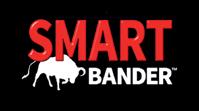
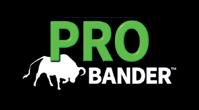


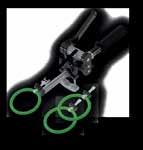

"The bottom line is that high-tension banding is faster, easier, and less traumatic for the animal than surgical castration. "

Matt Sween, UC Davis Animal Science Dept.

To stay competitive and profitable, you are challenged to look at both sides of the equation –the day-to-day costs, trends, and influences on your bottom line, as well as the key operational considerations. From minimizing your tax exposure to optimizing your operations, we’re here to help you get the most from your livestock operation.

On February 23, 2023, the United States Department of Agriculture (USDA) notified Canadian Food Inspection Agency (CFIA) that a heifer exported from Saskatchewan to a feedlot in Nebraska in September 2022, had tested positive for bovine tuberculosis (TB) at slaughter.
CFIA utilized animal movement records to determine:
• The heifer’s herd of origin, which they quarantined until testing could be completed.
• The heifer had not been on any other farm premises in Canada
• The heifer spent five months in a Canadian feedlot before being exported.
• All of the Canadian feedlot contact animals were destined for slaughter.
In May 2023, CFIA tested all animals over the age of six months, and removed the reactor animals for slaughter and enhanced post-mortem examination, which confirmed two initial positive cases in the herd on June 19, 2023.
Investigation Status as of December 24, 2023
Infected Herd
• One infected herd has been humanely depopulated and all testing is complete.
• There were 32 confirmed positive cases of bovine TB in that herd in total.
• The bovine TB strain found in the infected herd is consistent with the strain the USDA found in the infected heifer at the US feedlot; and it is not a close match to any strain previously reported in livestock or wildlife in North America.
Life Line Herds (i.e., herds traced from an infected animal in the infected herd)
• There is one life line herd, which CFIA lab tested and received negative culture results for all the reactors, before releasing the animals from quarantine.
Contact herds (i.e., herds that shared a fence line or may have co-mingled with the infected herd)
• There is one contact herd, which CFIA lab tested and received negative culture results for all reactors, before releasing the animals from quarantine.
Trace-in Herds (i.e., herds that provided animals to the infected herd)
• There are two trace-in herds, which CFIA lab tested and received negative culture results for all reactors, before releasing the animals from quarantine.
Trace-out Herds (i.e., herds that received animals from the infected herd)
• CFIA released four trace-out herds that completed herd-level testing from quarantine.
If
Terminal Feedlot where animals only go to slaughter
Non-terminal Feedlot where it may be in contact with breeding stock Yes
Yes, if the animal is mature enough; or it will be humanely destroyed. Yes
Bovine TB is a reportable disease. Any suspect cases must be reported to Canadian Food Inspection Agency.
It is most commonly spread through:
• Contact with infected animals' respiratory secretions and aerosols, feces, milk, urine, vaginal secretions, or semen; and
• Ingestion of contaminated food and water.
Progressive signs of disease:
• Weakness,
• Loss of appetite,
• Weight-loss,
• Fluctuating fever,
• Intermittent cough, and/or
• Lesions in the lymph nodes of the head and thorax, lung, spleen and liver.
While all investigations and response situations are different, the steps involved in a bovine TB investigation or response normally include:
• quarantine
• investigation
• destruction and disposal
• cleaning and disinfection
• compensation
• confidentiality
This activity remains important to ensure prompt detection and eradication of the disease to prevent its establishment and spread.
- Canadian Food Inspection Agency
• Live animal testing for one confirmed trace-out herd is complete.
• CFIA is continuing tracing work.
For trace-out animals found on nonterminal feedlots, an assessment of the disease risk status of other animals at the same premises will be completed, and live animal testing will be performed as needed. Any non-negative animals found on live animal testing will be sent for enhanced post-mortem examination, with tissues submitted to the laboratory.
The goal of CFIA’s program is the early detection and complete eradication of bovine TB from livestock in Canada.
Canadian Food Inspection Agency
• Industry Notice - Detection of bovine tuberculosis in Saskatchewan
https://inspection.canada.ca/animalhealth/terrestrial-animals/diseases/ reportable/bovine-tuberculosis/ saskatchewan-2023/detection/ eng/1687969580006/1687969846737
• Status of the bovine tuberculosis investigation status as of February 12, 2024
https://inspection.canada.ca/animalhealth/terrestrial-animals/diseases/ reportable/bovine-tuberculosis/ saskatchewan-2023/status/ eng/1689254193235/1689254193704
• What to expect if your farm is part of the investigation for bovine tuberculosis
https://inspection.canada.ca/animalhealth/terrestrial-animals/diseases/ reportable/bovine-tuberculosis/ farm-under-investigation/ eng/1449456995596/1449456996360

At a time when Canadian agriculture continues to struggle with a chronic worker shortage, new data from Canadian Agricultural Human Resource Council (CAHRC) has found that by the year 2030, there will be more than 100,000 vacant jobs to fill in the industry.
This labour market supply and demand forecast is a study conducted by The Conference Board of Canada, on behalf of CAHRC.
CAHRC found a 15 per cent increase in job vacancies compared to the number of jobs in 2022 that could not be filled by Canadians and residents of Canada. The report, titled Sowing Seeds of Change, states this is due in part to Canada’s aging population as more than 85,300 people—30 per cent of the workforce—are expected to retire over the same period.
The labour market information report says temporary foreign workers (TFW) will play an important role in narrowing the domestic labour gap. However, even with a projected increase in TFW employment by 2030, an estimated 20 per cent or 22,200 positions will remain vacant.
“Labour shortages are one of the most serious issues in agriculture because they have a direct impact on local food security, economic development and the sustainability of the sector,” says Jennifer Wright, executive director of CAHRC. “CAHRC’s labour market data offers the necessary insight to inform how we will tackle current and future challenges so our industry and its workforce can reach their full potential.”
The report, which also offers an in-depth analysis by provinces and subsectors, makes a suite of recommendations to attract and retain more agriculture workers. This includes public education to improve perceptions of agriculture, developing and updating human resource management practices, and adopting new technology and automation.
The labour market forecast is a key data source that informs CAHRC’s National Workforce Strategic Plan (NWSP), which exists as a national framework to address labour shortages and skill gaps throughout the sector. To date, more than 100 stakeholders, including primary producers, food and beverage manufacturers, educational institutions, producer groups, industry associations, and government officials, have participated in the development of this strategic plan.
This research and its publication were made possible through Employment and Social Development Canada’s (ESDC) Growing the Agriculture Workforce of the Future: Cultivating Canada’s PostPandemic Recovery initiative. This funding is part of Government of Canada’s Sectoral
Workplace Solutions Program (SWSP), which helps key sectors of the economy implement solutions to address their current and emerging workforce needs.
Canadian Agricultural Human Resource Council
New report from the Canadian Agricultural Human Resource Council projects job vacancies will surpass 100,000 by 2030 as nearly one-third of agri-workforce retires
Retrieved February 15, 2024
https://cahrc-ccrha.ca/cahrc/news-releases/ new-report-canadian-agricultural-humanresource-council-projects-job-vacancies
Agricultural Education and Vocational Center Sowing Seeds of Change
https://www.sowingseedsofchange.org/

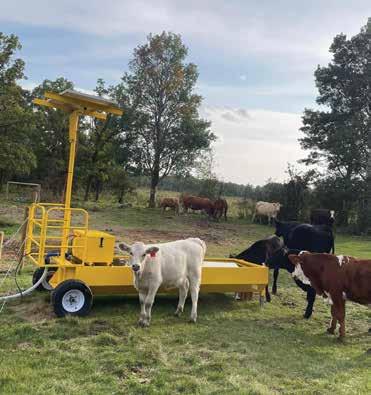

• PURCHASE A CHAROLAIS BULL FROM ANY SCA MEMBER (AND TRANSFER THE PAPERS)
• UNLIMITED ENTRIES ALLOWED
• BULLS CAN BE PURCHASED EITHER BY AUCTION OR PRIVATE TREATY
* BULLS MUST HAVE THEIR PAPERS TRANSFERRED IN ORDER TO BE ELIGIBLE FOR ENTRY
SPONSORED BY THE SASKATCHEWAN CHAROLAIS ASSOCIATION
JOIN US AT THE 2024 ANNUAL GENERAL MEETING IN CONJUNCTION WITH THE SASK ROYAL CHAROLAIS SALE IN MOOSE JAW, SK ON JUNE 6, 2024!
* TWO $1000 SCHOLARSHIP OPPORTUNITIES AVAILABLE!
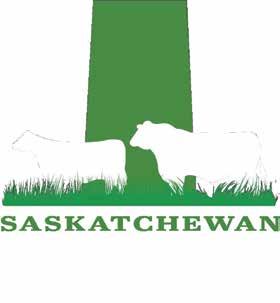
Applications for the 2024-2025 Youth Employment and Skills Program (YESP), delivered by Agriculture and Agri-Food Canada (AAFC), are now being accepted until March 25, 2024.
The Youth Employment and Skills Program helps support employers that hire youth (between the age of 15 and 30, inclusive) for agricultural jobs. Employment projects may start as early as April 1, 2024, and end no later than March 31, 2025.
YESP will prioritize applications from Indigenous applicants for the 20242025 program year, followed by all other first applications.
The program will continue to encourage applicants to hire youth facing employment barriers; however, it is not a requirement for eligibility.
Approval of secondary applications will be dependent on available funding and program uptake.
The list of barriers youth may face is as follows:
• Indigenous
• Living with a disability (physical, mental health-related or learning disability)
• Racialized youth (formerly visible minority)
• Recent newcomer to Canada
offering our best.

• GRASSFED: “True North Foods is partnered with A&W Canada to supply Canadian grassfed beef for A&W’s grassfed burger program.
• SERVICES: Whether you are a specialty producer looking to get your product to a specific market or distributor, or if you are producing commodity livestock for sale, we can partner with you. From our multi-species capabilities to our ability to handle smaller volumes, we offer excellent capabilities for producers in the Canadian Prairies to maximize their profitability.
• FACILITY: We have a state-of-the-art facility to allow us to reach markets across Canada, the USA, and beyond. We understand producer’s needs, their care for their animals, and their honest, straightforward nature. Call us to hear how we can work together to get your product to market.
www.truenorthfoods.ca
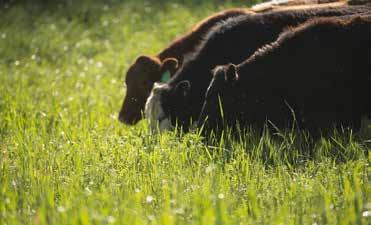
• 2SLGBTQQIA+
• Person living in an Official Languages Minority Community (OLMC)
• Residing in a remote, northern and/or fly-in-community
• Living in a low-income household
• Single parent
• Individual who left high school
AAFC reserves the right to limit the number of approved projects per applicant so that funding can be equitably distributed.
Application intake will close midnight Eastern Standard Time on March 25, 2024.
For additional information on this program, and to apply, visit agriculture.canada.ca and enter “Youth Employment and Skills Program” into the search bar at the top of the page.
B
The Youth Employment and Skills Program will contribute approximately $13.5 million to projects that employ Canadian youth and youth facing barriers (ages 15-30), helping them develop the skills and gain the experience they need to transition into the labour market successfully.
Each project will be eligible to receive up to $14,000 in matching funds to employ one employee.
Saskatchewan forage and livestock producers remain resilient, as drought challenges their operations. In 2021 to 2023, sourcing and transporting feed in tight supply highlighted the importance of available and timely cash flow for livestock producers.
The Saskatchewan Crop Insurance Corporation’s (SCIC) Weather-Based Programs are designed to protect producers against weather-related risks. Programs include the Forage Rainfall Insurance Program, Mixed Forage Rainfall Insurance Program, Intercrop Rainfall Insurance Program, Corn Rainfall Insurance Program and Corn Heat Unit Insurance Program.
In 2023, the Forage Rainfall Insurance Program paid a record-breaking $60.4 million total indemnities to participating producers across 17 forage risk zones. Over 90 per cent of the 3.35 million insured acres enrolled received a payment. In 2023, the average Forage Rainfall Insurance Program premium cost per producer was $3.35 per acre. The average claim payment resulted in $19.44 per acre.
These results are a testament to how closely SCIC works with Saskatchewan livestock industry groups to ensure business risk management programs remain relevant to producers’ needs. SCIC continues to lead collaboration through its Forage Working Group to make recommendations for
continued on page 18

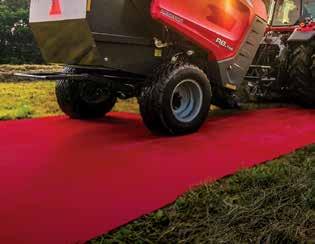



enhancements to SCIC’s forage programs.
This working group includes members from the Saskatchewan Cattlemen’s Association, Saskatchewan Stock Growers Association, Saskatchewan Forage Council, Saskatchewan Association of Rural Municipalities and The Agricultural Producers Association of Saskatchewan.
In 2022, a notable enhancement was the addition of the excess heat adjustment to these weather-based programs. This enhancement, which reduces rainfall accumulations in situations of high heat to account for the loss of moisture available to the plant, results in a higher likelihood of receiving a payment.
For the Forage Rainfall Insurance Program and the Corn Rainfall Insurance Program claim calculations, the monthly accumulated precipitation was reduced by 1.0 millimetre for any day in the month a station reaches 31.0 degrees Celsius. In 2023, the excess heat adjustment accounted for $5.8 million of total indemnity paid to producers.
Saskatchewan producers strive for optimal production through good growing conditions. As with other forms of insurance, purchasing insurance is not about making money—it is about proactive planning to have protection when you need it. SCIC
recognizes no growing season is the same. Each can bring its own set of production challenges. A good indicator of an effective program is not how it responds to the good growing season but examining returns to producers during challenging ones.
Over the last five years, Saskatchewan experienced significant dry conditions and drought pressures. The Forage Rainfall Insurance Program responded accordingly. On average across the province, the Program paid $4.40 in eligible claims for every $1.00 of producer paid premium. Claims are based on precipitation at the weather stations. Individual’s precipitation values may vary, relative to proximity to the stations.
Introduced for the 2024 Crop Insurance Program, SCIC’s weatherbased programs now provide options to insure intercrops, along with crops for grazing and livestock feed.
• The Mixed Forage Rainfall Insurance Program: protects any forage feed crop not previously covered under weatherbased programs, including greenfeed and silage, if seasonal precipitation is below average.
• The Intercrop Rainfall Insurance Program: protects annual intercrops intended for harvest, if seasonal precipitation is
cont. from pg. 17 continued on page 20

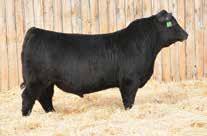



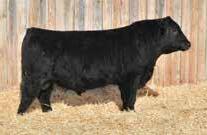

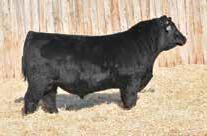
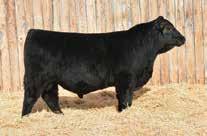

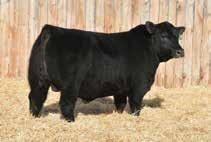





SCIC Weather-Based Programs cont. from pg. 18
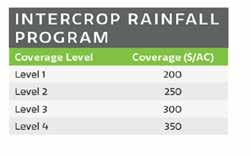

below average. Any intercrop mix is now insurable under this program, which also includes an establishment benefit.
All weather-based programs are enhanced by increased weather station density province-wide. Most land is located within 30 kilometres of at least one weather station. One weather station can be selected for each insured and location. This allows producers to insure each of their land locations with relevant coverage.
The Forage Rainfall Insurance Program insures all types of grazing and tame hay acres, protecting pasture and hay land. Similarly, the Corn Rainfall Insurance Program insures against a lack of moisture over the growing season for seeded corn, whether it be for grain, silage or grazing.
Actual precipitation at a weather station is compared to the long-term average to determine the “monthly per cent of normal” precipitation. This is multiplied by the monthly weighting and calculated each month of the growing season. A producer is in a claim position when the precipitation at their selected weather station is below 80 per cent of normal.
Producers can select several different options to customize their rainfall coverage:


• Weather stations – Data for these programs are collected from a network of weather stations across the province. Producers can select any station within 100 kilometres of their insured land.
• Weighting option – Choosing different monthly weighting options for each insured land location allows producers to determine when rainfall is the most important for their land.
• Precipitation cap – To help ensure a large weather event in one month does not impact indemnities, producers select a cap of either 125 or 150 per cent of normal precipitation for each insured land location. Any precipitation above this selected cap in any month is not included in the claim calculation.
• Coverage level – Select from three levels of coverage (low, medium and high), offering flexible risk management and related premium cost options. For 2024: Coverage levels now better reflect the productive capacity of the insured acres. An increased transportation allowance recognizes the costs associated with replacing lost feed.
The Forage Rainfall Insurance Program coverage levels are set, each year, based on seasonal forage prices. Producers can select from a range of coverage dependent on the soil zone and the type of insured forage. The Corn Rainfall Insurance Program coverage is based upon dollarper-acre values and reviewed periodically, based on market conditions.
Rainfall calculations for programs are completed monthly. Data is available at www.scic.ca/resources/statistics by the following mid-month.
An added benefit of the Forage Rainfall Insurance Program is year-long fire insurance coverage. If the insured area experiences an accidental fire, an adjuster inspects acres to confirm the cause of loss.
continued on page 22
Selection Required Options
Soil Zone Brown Dark Brown
Black/Grey – Land location dependent
Forage Type
Tame Grazing Native Grazing Tame Hay Coverage
Precipitation Cap 125 per cent of normal
per cent of normal
Weather Station
Weighting Options
(% April, May, June, July)
Selected by customer (within 100 kilometres of land)
*Selection must be made for all land descriptions of that forage type but can differ among forage types.
Selection Required Options
Coverage Level $150.00, $175.00, $250.00 or $350.00
Precipitation Cap 125 or 150 per cent of normal
Weather Station
Weighting Options
(% May, June, July, August)
Selected by customer (within 100 kilometres of land)
20-40-40-00 15-35-35-15 00-20-40-40
SCIC Weather-Based Programs cont. from pg. 21
This Program provides risk management for corn producers who experience low temperatures during the growing season or early frost. The Corn Heat Unit Insurance Program starts accumulating corn heat units on May 15 of each year and stops when an individual station reaches negative 1.0 degree Celsius for any length of time.
Program payments are based on the current year’s accumulated corn heat units compared to long-term normal (which is based on historical weather data from each weather station). If the program year has less than 95 per cent of normal corn heat
units, the producer is in a claim position.
For each per cent below 95, the producer receives four per cent of the insured coverage. Under this program, producers can select the coverage options of $150.00, $175.00, $250.00 and $350.00 per acre.
If a producer participates in both the Corn Heat Unit Insurance Program and the Corn Rainfall Insurance Program, coverage is automatically selected at $175.00 for each program.
SCIC offers various business risk management programs to meet the needs
of forage and livestock producers. SCIC encourages producers to review their coverage and available options. Contact SCIC to build a risk management plan to meet the needs of your operation!
March 31 is the deadline to apply, reinstate, cancel or make changes to your Crop Insurance contract.
SCIC has 21 local customer service offices throughout the province. Producers can also visit SCIC online at www.scic.ca or call 1-888-935-0000. B



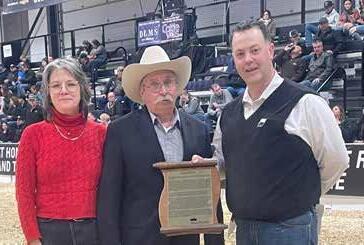
Calvin was born August 22, 1960, in Rockglen, SK. Calvin grew up on a family farm in Southern Saskatchewan. Calvin along with his brother and father operated a mixed grain and a commercial cowcalf operation. In addition to the grain and cow-calf operation, they ran a calf backgrounding and feedlot operation.
Sandra (Sandor) was born in Lafleche, SK, on September 26, 1960, and was raised on a small mixed farm in Southern Saskatchewan. Calvin attended school in Rockglen while Sandra attended school in Glentworth.
After high school, Calvin attended the School of Agriculture at the University of Saskatchewan before moving back to the farm at Rockglen, SK. Sandra pursued a Education at University of Saskatchewan in the Arts and Science department. On June 19, 1982, the couple were married and raised two children Brett Knoss of Rockglen, and Hayley Knoss of Westminister, BC.
In his early years, Calvin and his brother grew up showing Maine-Anjou and Chianna cattle. Calvin was also very active in the 4-H Light Horse Club. In later years, they showed commercial calves and bred heifers at Canadian Western Agribition. Calvin showed the first pen of 10 heifers, several champion pens of 20 steers and a banner for the pen of 10 heifer calves at Canadian Western Agribition.
Calvin has been instrumental in the agriculture industry at local, provincial and federal levels. Through his many years with Saskatchewan Stock Growers Association (SSGA), Calvin was involved as president, vice president and finance chair; and served on the Zone Committee and chaired it. He also served on the Livestock Policy Advisory Council and the Horned Cattle Trust Fund.
Calvin was involved at the national level as the Saskatchewan director of Canadian Cattlemen Association; and while he was there, he served as vice chair on the Domestic Ag Committee. This list continues as Calvin also served as director and president of Saskatchewan Livestock Association, founding director and president of Western Beef Development Centre, and founding director of Canada Beef Cattle Research Council. Other organizations Calvin has worked with include Saskatchewan Ag Hall of Fame, National Farm Net Committee, Saskatchewan Stock Growers Foundation and Saskatchewan Association of Watersheds.
In the local community, Calvin and Sandra have been very active and engaged in multiple groups. Calvin serves on the Air Cadets Parent Committee, Scouts Canada, Rural Municipality 12 Council, Borderland Veterinary Board and the South Sask
Ready Economic Development Board. Sandra works with the Girl Guides of Canada, Rockglen Library Board, Rockglen Rec Board and Rockglen Arts in the Park. Sandra has been a lifelong artist and has participated in many art shows provincially and nationally, depicting the beauty of the Saskatchewan landscape.
Congratulations, Calvin and Sandra Knoss!
Saskatchewan Livestock Association established the Honour Scroll awards to celebrate farm families that make outstanding contributions to the livestock industry, their communities and province of Saskatchewan.
To ensure the Honour Scroll program continues, SSGA accepted the responsibility for presenting these distinguished awards on behalf of Saskatchewan Livestock Association, as of 2023, to commemorate Saskatchewan Livestock Association and the significance of its historical achievements to Canadian Prairie agriculture.

Ken Bell was born on May 13, 1949, in Regina, Saskatchewan. Raised on the family farm near Pense, Ken attended elementary school in the Bruceville School District and went to high school in Moose Jaw and Lumsden. His family farm was home to Bell Angus, established in 1942, and he grew up in the cattle business. Ken also enjoyed sports, including baseball, hockey and curling and he continued to pursue those interests for many years.
Always a cattleman, Ken enjoyed showing cattle at the summer fairs, including those in Regina and Moose Jaw. He also exhibited cattle at the Toronto Royal Agricultural Winter Fair and Canadian Western Agribition for many years; and he continues to be involved as a volunteer at Canadian Western Agribition cattle shows.
A founding member of the Triple A Bull Sale, Ken participated in the Triplex Sale and was involved in the Fall Finale Sale for many years. Ken committed his time and expertise as a volunteer to a number of beef cattle organizations, including Saskatchewan Angus Association where he served as a board member, Saskatchewan Cattle Breeders Association and the Regina Bull Sale. Ken also served Canadian Angus
Association as its honourary president.
In 2009, Ken married Sheila Fishley McNally, and welcomed Amanda Gillespie, Ryan and Jason McNally to his life. These days, Ken and Sheila live in Lumsden, SK, while continuing to manage their family farm near Pense, where the Bell Angus tradition is now in its 82nd year.
Ken and Sheila are very active in their community. Ken has devoted time to fundraising efforts for local organizations, including Lumsden Curling Club and Lumsden Lions Club, and continues to serve the Lions Club as an active member and volunteer.
In recognition of his contribution to the community and the livestock industry, the Honour Scroll was presented to Kenneth Norman Bell at the 2023 Canadian Western Agribition Angus Show.
Congratulations, Ken Bell! B
Industry members are invited to nominate individuals that have made a significant contribution to Saskatchewan agriculture for the Honour Scroll award by acquiring, completing and submitting an Honour Scroll Nomination Form to Saskatchewan Stock Growers Association for consideration.
Annual Deadline for Nominations: May 1
The information you will need to complete the form includes: full name and contact information, place and date of birth, family and education details, family history, activities and professional highlights, and contributions to community, province and country.
Submissions are voted on by SSGA's Board of Directors and may be awarded at a variety of events in the province each year.
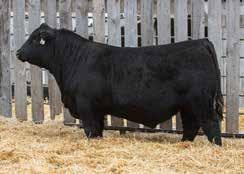


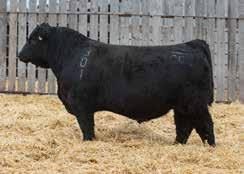

Established in 1995 through member donations matched by Saskatchewan Environment’s Fish and Wildlife Development Fund, and presented at the Annual General Meeting each June, Saskatchewan Stock Growers Association’s Rangeland Scholarship is an annual $1,000 award that honours beef producers known for their exceptional leadership skills, community involvement and academics.
To learn more about the Rangeland Scholarship, including the nomination process, please visit: skstockgrowers.com/rangeland-scholarship.
To be eligible, the applicant:
• Must be a Saskatchewan resident.
• Or a family member must be a current SSGA member.
• Must be enrolled in a post-secondary institution in a program related to range management. (Preference will be given to a third-year student.)
The livestock industry celebrates beef producers that apply best practices to a wide range of conservation and land stewardship initiatives—producers that continually seek out ways to innovate and adapt to protect and enhance their operation and the environment.
TESA does that too, at the provincial and national level. After receiving provincial recognition for their dedication to creating a sustainable future for Canadian agriculture, producers move forward as nominees for national recognition.
Saskatchewan Stock Growers Association invites nominations for TESA at the provincial level and provides a full description of the award and the nomination process here:
skstockgrowers.com/tesa-award
Eligibility: All beef cattle producers in Saskatchewan are eligible for this award. Producers can nominate themselves or be nominated by another person, or organization.
Annual Deadline for Nominations: May 1 B B
Annual Deadline for Nominations: May 1
For more information visit www.canfax.ca



Ranch cattle like Angus and Charolais have something in common with dairy breeds like Jersey and Holstein: ultimately, they all end up as beef cattle.
The technique of breeding beef genetics onto dairy cows is helping dairy operations improve their non-dairy production and build their financial bottom lines.
Dairy herds obviously need cows, and like any livestock operation, a dairy will select its best performers and breed them to produce replacement heifers. A dairy farm will typically replace 25 to 30 per cent of its producing cows in a year.
But all of the cows are bred, because they have to keep producing milk. If a dairy has 100 cows, they will typically have 100 calves each year (more or less). Of the heifer calves, a couple dozen will make the grade as replacements, and the other calves— heifers and steers—will be sold as beef.
While recent improvements in the viability of sexed semen allow dairy operations to target their best cows to bear replacement females, the beef-on-dairy breeding practice helps improve the value of the calves that aren’t bound for the milking barn.
Derek Westeringh runs a dairy farm at Warman and is on SaskMilk’s Board of Directors. He says that since beef production isn’t the bread-and-butter of his operation, it has to be managed efficiently. Otherwise it could easily become a cost centre rather than a source of revenue.

“The dairy is the number-one business on our farm. It’s the main business,” he said. What he sees in beef is a synergistic business that can make milk production more efficient.
“We want to put top-notch feed on our dairy cows. We want to make sure they get fresh feed every day, and not eating day-old feed. We want to make sure the milk that goes into our calves is good, healthy milk.”
But there’s always a little bit of rot, or some refusals left over from the previous day’s feed. Westeringh said they used to gather that up and spread it on their field, but he realized if he was raising the right animals for the beef chain, he could use that scrap feed more efficiently.
“For me, that’s really where this idea was born,” he said. “Kind of like hey, I wonder if we could get an animal that will lick all this stuff up. Put an animal in front of it and see. And so that’s what I mean when I say it’s a synergistic thing.”
Cleaning up the leftovers is only a part of the feed-efficiency picture. The other part is the performance of the calf and its value when it leaves the farm for a feedlot.
Holstein beef tends to grade very well, with a high percentage at AAA or Choice. But the breed was developed for dairy production, not for performance as a beef animal, and finishing an animal can take a long time. Breeding Angus genetics onto a Holstein cow makes for a betterperforming, higher-value calf.
“If you put Holstein steers on feed, you’re looking at about 18 to 19 months to finish them out,” Westeringh said. “They’re just genetically not meant to put the weight on the way the beef animal is.”
But the beef-on-dairy cross, he says, performs much better.
“The feed efficiency is significantly better. We’ll finish them out in about 15 months, as opposed to 18,” he said, adding that the heterosis advantage from cross-breeding also contributes to a healthier and more resilient animal.
Dr. Kee Jim is a veterinarian, founder of Feedlot Health Management Services Ltd., and senior leader of the animal agriculture team at TELUS Agriculture & Consumer Goods. He says the weaning regimen and transition to full feed is faster for the beefdairy cross calves than for beef calves, resulting in younger animals available for slaughter and a desirable beef product.
“Their production system is such that they’re on full feed at an earlier point in life. They’re not in a conventional beef cow system, where they’re on the mother cow for a significant period of time and then they go into the feedlot. Or alternatively, they go into a grazing system, and they get much older before they’re slaughtered. And that’s negative on eating experience because as animals get older, they get less tender,” Jim said.
“On average, these cattle coming out of the dairy system are quite a bit younger when slaughtered. And so not only do they have
continued on page 30
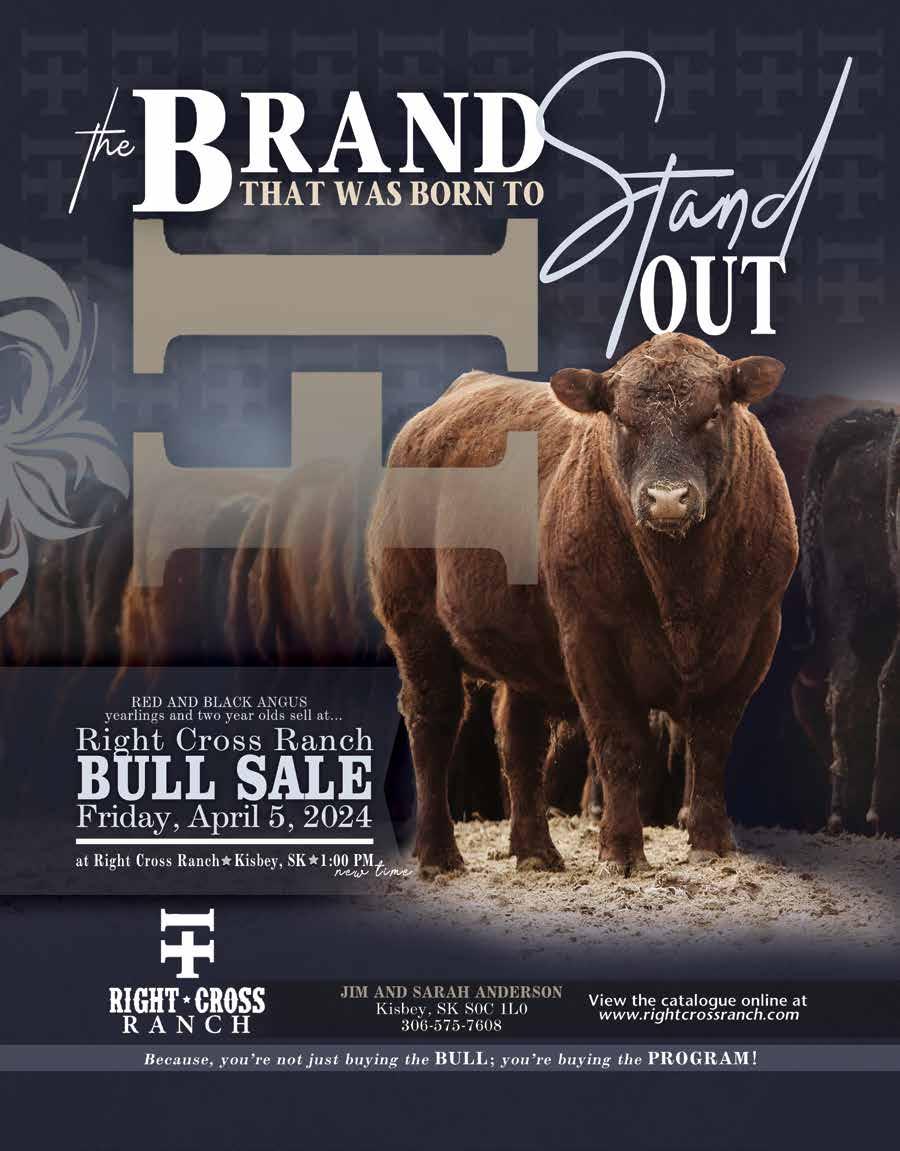
marbling, they’re also very tender because of their youthful carcasses.”
Jim says the beef-on-dairy cattle gain five to 10 per cent faster than straight dairy cattle, and their conversions are much better. “They’re grading roughly 10 per cent more AAAs or Choice as well. So, it’s a win-win-win across all of those categories.”
He said feedlots are willing to pay more for the beef-on-dairy cattle because of the growth rate conversion and the carcass attributes. And packers, who have always bought Holstein steers, don’t view the beef-on-dairy cattle any differently, because they retain the better grading of the Holsteins.
“From their perspective it’s a product that’s easier for them to sell, because generally, they’re seeking cattle with better marbling characteristics,” he said. “So the whole impact of using beef cattle in the dairy system is positive. There’s no negative of any kind in the entire system.”
Meanwhile, it’s clearly in the dairy producers’ best interest to produce as many females as possible—especially, from their best-producing milk cows. With conventional breeding, even using artificial insemination, a farm’s cows would yield only 50 per cent female calves. Sexed semen allows the operation to tip the odds in favour of female calves. According to Jim, sexed semen has made big strides in its success rate over the past 10 years or so, which adds up to big advantages at the farm level.
them to target their best cows in the herd, so they get replacement heifers out of their very best genetics.”
Beef Genetics cont. from pg. 28 B
“Sexed semen started to become much more viable—meaning, the conception rates obtained with sexed semen are similar to that of conventional semen,” Jim said. “And that was really a game-changer, because now it allows the dairy producer to produce 90 per cent heifers and 10 per cent steers out of that semen. That allows
Westeringh says most dairy operations use Angus semen for their beef-ondairy program, and that’s how he started out. But lately he’s been experimenting, and he likes the results he has seen using Charolais.
“I’ve been using Angus ever since we started the program, but I’ve recently switched to Charolais. I’ve found that I was able to get a Charolais-cross up to 400 pounds, 18 to 20 days faster than an Angus-cross,” he said.
But there are advantages to Angus too, especially as far as market awareness is concerned.
“The Certified Angus program is a really good program in the meat market,” Westeringh said. “In order to get certified, an animal only needs to be 50 per cent Angus, so you can breed a Holstein with Angus semen, and you can get offspring that can be a Certified Angus product, technically.”
Westeringh and Jim agree beef-on-dairy has no negative implications for the ranching sector.
Jim says there are approximately one million dairy cows in Canada, and 10 times that many in United States.
“So each year, you would have up to half a million Holstein steers entering into the system in Canada. And you’d have roughly 10 times that many—five million steers— entering into the feedlot production chain in United States,” Jim explained.
“What it means is that every time you go to the grocery store, you would have, roughly, a one-in-five chance that the beef you purchase could have been a Holstein steer. That was the way the business worked for
many years,” he said. “But starting in about 2010 or somewhere in that timeframe, sexed semen started to become much more viable.”
That meant that up to half of the dairy cows would potentially be bred with beef animals. That one-in-five share of the supermarket meat case is not necessarily Holstein anymore, but a hybrid with better value at every step in the supply chain.
Jim said beef on dairy isn’t putting any more cattle into the supply system, simply because the number of dairy cows is fairly stable—and each cow will still only have one calf per year. But the product brings more value to the sector while still providing high-quality beef for consumers.
Currently, he said, “there are a couple million doses of beef semen sold across North America. This beef on dairy thing could increase that number by five- to sixfold. So, if you’re a seedstock producer, and you have high-quality genetics, and you’re producing the type of cattle that are wanted in these programs, you have a pretty big economic opportunity.”
As Westeringh puts it, “it’s not changing the number of cattle we’re producing. It’s changing the colour, and it’s changing the feed efficiency.
“But there’s going to be a need for the semen, because where is the dairy industry going to be getting the semen from? We’re going to have to lean on our brothers in the beef industry,” he said.
“We’re all beef farmers, you know. At the end of the dairy cow’s life, it goes to a beef plant. So, no, I think this is good for the beef industry.”

Developing a sustainable wintering plan that protects a producer’s property and cattle involves the development of customized strategies that address infrastructure enhancement, farm, resource and feed management.
In addition to reducing feed, operating and labour costs, effective wintering plans can enhance soil fertility, naturally; expand the range of feeds that can be utilized; decrease bedding expenses; reduce nutrient accumulation and groundcover loss; and cut animal health costs.
While these planned benefits are designed to support overall herd health, there are also best practices designed for calves, which are far more vulnerable to colder temperatures than mature cattle.
Like other warm-blooded mammals, cattle have a range of environmental temperatures where they are able to maintain a comfortable, and fairly constant, core temperature without needing extra energy to do so. This species-specific range is called the thermoneutral zone, and it is between 38.5 and 39.5 degrees Celsius for a bovine calf.
Though summer’s hot and dry conditions can be problematic for any age of cattle, winter’s cold, wet and windy conditions can be particularly dangerous for calves.
And since Canada’s coldest months host calving season for most livestock operations, Beef Business contacted Dr. Andrew Acton, owner and operator of Deep South Animal Clinic and a commercial herd of Simmental and Angus in Ogema, Saskatchewan, to share his recommendations for optimizing calf survival rates through the winter.
Beef Business: Aware that bedding and windbreaks can greatly reduce the impact of low temperatures, moisture and wind chill on cattle, what types of materials do you recommend for reducing cold stress on calves?
Dr. Andrew Acton: For bedding, I almost always go with cereal straw from wheat, durum or barley. Whether it’s from your own operation or your neighbour’s farm, the straw can be rolled out or put through a bale shredder to make a good, bedded pack for cows and calves.
Tree lines and shrubs can be helpful, but are not always sufficient wind protection for cattle in the Canadian Prairies. Like all business decisions, selecting the right windbreak depends on the unique needs of each livestock operation. I think the best shelter from wind is in the form of a porosity windbreak, which reduces the amount and speed of wind in an area.
I found a great explanation for what to do in your yard, in a couple of articles posted on drovers.com. You can find both of those articles by entering the titles into the search bar at the top of that web page.
The first article is called: Windbreaks for Cattle Protection and Snow Diversion Explained. The second is: Livestock Windbreak Design Principles and Resources.
Beef Business: Detecting the early signs and symptoms of weather-related health conditions effectively prompts producers to take action before serious problems arise. What are the most common signs and symptoms of frostbite and hypothermia in calves?
Dr. Andrew Acton: You are going to find a calf with possibly or obviously-frozen ears, a partially-frozen tail, and sometimes even frozen feet. It’s not what it looks like, it’s more about what it feels like. That anatomy could feel frozen solid, literally.
Timely detection is important. You can warm up a calf when you recognize the signs and symptoms early.
In the case that you find a calf—after its frozen ears, tail or feet have thawed naturally—and, if the calf isn’t too damaged by it, you’re going to notice swollen ears
FOUR KEY AREAS for planning a sustainable wintering system:
Infrastructure Enhancement
Paddock development
Water facilities
Shelter
Field accesses
Runoff controls
Farm Management
Site location
Animal mobility
Animal density
Pressure on paddocks
Field rotation
Manure
Resource Management
Ground and surface
water protection
Riparian protection
Habitat protection
Feeding Strategies
Extended grazing
Modified traditional practices
- Manitoba Agriculture www.gov.mb.ca/agriculture
and a swollen tail that are usually painful when touched. You may also see a calf that is quite sore on its feet compared to other calves.
However, it takes a while for that evidence to show up. Over time, those ears could curl up and fall off.
In the case of frozen feet, partial lameness, loss of hoof or structures underneath the hoof, can occur. In any cases like that, calves should be euthanized sooner rather than later.
Beef Business: What is the best way to take a calf’s temperature, and what is the healthy temperature range for calves?
Dr. Andrew Acton: A really important piece of equipment to carry with you, and keep handy, is a digital thermometer. Taking a rectal temperature with it will show the
continued on page 34

Cold Weather Calf Care cont. from pg. 32
calf’s exact body temperature, and how critical their hypothermia may be.
Any calf that is above 38 degrees Celsius is likely just fine. And if you happen to be in a storm, or there’s a bad cold snap, you need to make sure your calves are out of the wind and dry.
If a calf’s temperature is between 35 and 37 degrees, the calf is too cold; so, you would need to get it to a heated area and dried off.
And, you need to be prepared for dealing with a struggling calf as it begins to warm up!
When you’ve got it back to a normal body temperature that’s above 37 degrees, you will need to dry the calf’s hair and skin completely before you can leave it to rest up in a barn situation.
Day-one is key to a calf's survival
Most of the time, we can warm up calves using the warm air method, instead of warm water baths. The warm air method involves drying off the calf with towels and a hair dryer, and possibly using some sort of a warming hot box—without allowing the calf to become overheated.
If a calf’s temperature is below 35 degrees, you have some work ahead of you. It will be your top priority to get that calf warmed up and dried off before any extra injury or shock occurs.
Beef Business: What are the best ways to warm up a calf that has a temperature below 35 degrees Celsius?
Dr. Andrew Acton: There are two main ways to warm up calves: warm water, and warm air.
When a calf is extremely cold, the only option may be using a warm water bath. However, I am not a big fan of these because they are very labour intensive. You have to do it properly, and you have to ensure the calf is completely dried off after the bath.
To start, you need to get the water to a temperature of 38 to 40 degrees Celsius, maximum—so as not to overheat the calf and cause further damage to damaged tissues.
You need to circulate the bath water and check it continually, to ensure it remains in the correct temperature range of 38 to 40 degrees.
You must stay with the calf to ensure it doesn’t drown. You cannot leave it unattended.
There are some commercially-produced hot boxes, and some homemade versions, that use hot air to warm up a calf over time.
Whether you use the water bath or the air method, the calf should be warmed up at a reasonable pace only. Warming a calf too quickly can be just as stressful for it as hypothermia.
At the end of the day, the key words are warm and dry. Best practice requires using the thermometer, often.
A dose of warm colostrum now will warm from the inside, and provide vital energy to allow the calf to keep warming on its own. At least 50ml of colostrum per kilogram of calf (i.e., 25 millilitres per pound) is a good start for colostrum intake.
I would be in favour of any products that protect a calf’s ears, if the producer can manage it. However, the ear protection must not obstruct the calf’s vision or breathing. If used, ear protection should not be used in place of having appropriate windbreak for a calf, and a producer should keep an eye on the animal.
Beef Business: What are the risks for future health problems after frostbite and hypothermia have occurred?
Dr. Andrew Acton: The direct risks for hypothermic events are loss of extremi-

ties, including: losing the tip of the tail; a small, medium or large part of the ears; and most significantly, mild damage to the feet which might not be noticeable on a young calf, but may show up later when the animal is becoming a large size in the feedlot. This would be part of the reason why short-eared calves are discounted at sale during the fall.
The consequences for hypothermic events would be related to the calf’s general health. If a calf doesn’t have a good start in life, it likely didn’t have a good first suck of colostrum which, at very least, means the calf won’t grow as it should. It may also be more vulnerable to scours, pneumonia, navel infection, and being a chronically poor-doing calf.
That being said, once a calf is up and has nursed, it can stand a lot of cold weather. It’s important to remember that severe cold and direct wind can affect older calves’ ears too. Though, some breeds can be a little tougher than others in terms of skin and ear thickness.
Making sure a calf has ample opportunity to nurse with its mother, in its first day of life, will prevent a lot of future problems with that animal. Day-one is key to a calf’s survival.
continued on page 36







Beef Business: Developing a sustainable wintering plan that includes specialized care to protect calves from winter’s cold, wet and windy conditions can give them the best chance for achieving their full potential.
Sharing your invaluable time and knowledge to develop this article supports our readers to optimize their calf crops and bottom lines. Thank you, Dr. Acton.
Cold Weather Calf Care cont. from pg. 34 B
REFERENCES
Manitoba Agriculture, Food and Rural Initiatives
• Sustainable Livestock Wintering: How Can it Work for You?
https://www.gov.mb.ca/agriculture/ crops/crop-management/forages/ sustainable-livestock-wintering-howcan-it-work-for-you.html
Drovers
• Windbreaks for Cattle Protection and Snow Diversion Explained
https://www.drovers.com/news/beefproduction/windbreaks-cattle-protectionand-snow-diversion-explained
• Livestock Windbreak Design Principles and Resources
https://www.drovers.com/news/livestockwindbreak-design-principles-andresources
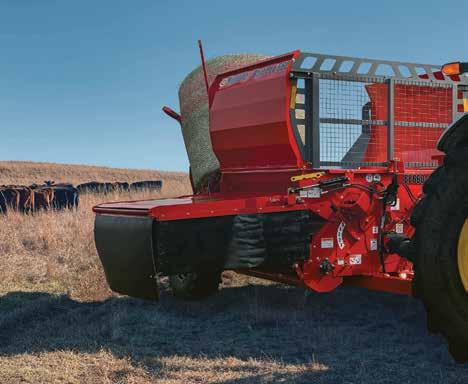
For more information, visit:
Chew on this: for optimum feed or bedding, these machines have bite. Highline® Bale Processors and Feed Mixers from Brandt deliver: more.brandt.ca/john-deere
Prominent Feed Mixer tub dividers mean excellent mix consistency with minimal mixing dead spots.
Bale Processor shafts are made from a single length of material, improving strength and durability.
Both are backed by the best-trained technicians and parts availability, delivered by Brandt.

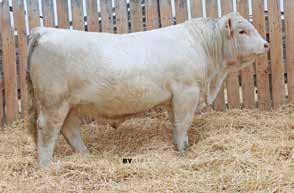
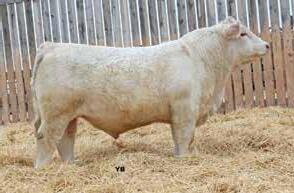
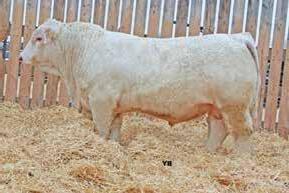
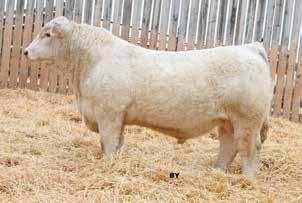



For over 50 years , Merck Animal Health’s commitment to vaccine research and development has helped pave the road to healthier Canadian cattle.
Our major contributions include:
Nasalgen® IP
1969 - First intranasal vaccine for cattle sold in the US
Vision®
1995 - First low reactive, subcutaneous (SQ) clostridial vaccine sold in the US, administered in a 2 mL dose
Bovilis® Guardian®
2005 - First and only scours vaccine labeled for SQ administration

Vista®
2006 - First bovine respiratory disease (BRD) vaccine to offer bovine viral diarrhea (BVD) Type 2 protection
Once PMH® IN
2014 - First intranasal vaccine offering dual bacterial pneumonia protection
Bovilis® Nasalgen® 3-PMH
2021 - First and only 5-way intranasal vaccine that helps protect against both viral and bacterial BRD pathogens with a single dose
The ONLY INTRANASAL vaccine that helps provide 5-IN-1 protection against BRD.
• Helps provide broad respiratory protection against five of the most common viral and bacterial causes of BRD* in just ONE convenient dose.
• Allows for vaccination as early as one week of age, without having to worry about potential maternal antibody interference.1
• Contains a proprietary BluShadowTM diluent that helps clearly identify vaccinated animals – no more second-guessing!

* Infectious bovine rhinotracheitis virus (IBR), bovine respiratory syncytial virus (BRSV), parainfluenza 3 virus (PI3), Mannheimiahaemolytica and Pasteurellamultocida
DUAL clostridial and histophilussomni(haemophilussomnus) coverage in a unique low-volume 2-mL vaccine with advanced antigen delivery.
• Helps protect against eight important clostridial pathogens, PLUS histophilus somni, one of the three major bacterial pathogens associated with BRD.2,3
• Advanced antigen delivery system with patented SPUR® technology helps induce immune response.
• Low-volume 2-mL SQ administration was shown to result in fewer and less severe injection-site reactions (vs. higher-volume 5-mL clostridial vaccines).4


As many cow-calf producers can appreciate, pregnancy rates this last fall were lower than expected, and in some cases, can best be described as exceptionally poor. Dr. Andy Acton, Deep South Animal Clinic, noted that a 20 per cent open rate was common as opposed to more typical rates of five to seven per cent. Furthermore, open rates of 50 per cent or more were seen in first and second calf heifers.
These observations are echoed by Dr. Nadine Wohlgemuth, Virden Animal Hospital, who commented that more typical open rates of eight to 10 per cent are now averaging closer to 15 per cent. And whereas the early calvers (January to the end of March), had near normal pregnancy rates, those calving in April and onwards had the worst rates, with one herd having 75 per cent open. No doubt the cumulative effects of three years of drought is showing up in pregnancy rates.
As Dr. Acton noted, “The females were conceived in a drought, born in a drought and raised in a drought.”
Dr. Laurie Zemlak, Peak Veterinary Health, made the following observations, underscoring that the drought has been going on for longer than three years.
“Although the last three years have been the most noticeable with drought, we’ve had multiple producers battling with poor water quality or availability as well as limited quality feed sources since 2017/2018 winter. The prolonged issues we’ve seen have been compounding and
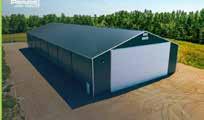
most pronounced this year.”, and she goes onto say, “I did notice a significant number of cattle with very small repro tracts and difficult to palpate (down to prepubertal levels), which I’d attribute to lack of cyclic activity for a significant time period.”
The following is a brief overview of a herd investigation that Dr. Nathan Erickson performed on a herd that had a 25 per cent open rate. What he found is fairly typical of what herds in Western Canada have been experiencing.
His investigation began with a review of the 2023 calving records, which revealed that only 40 per cent of females had calved in the first 21 days, instead of the expected 66 per cent. This finding suggests that reproductive issues may have begun the previous year with too many females being bred on the second and third heat cycles.
Next, he conducted body condition scoring on a subset of pregnant and open cattle. This simple procedure found that 82 per cent of open animals had a body condition score of <3 compared to 36 per cent of the bred animals. In short, the open animals were thinner than those that were pregnant.
Blood testing for mineral deficiencies was also performed; however, the results were equivocal, which is not unusual. Liver biopsies are a better indicator of mineral status but take significantly more time and expertise to obtain.
Dr. Erickson’s overall impression of the data was as follows. The relatively low

proportion of births in the first cycle alone indicates the cattle were not cycling early enough in the 2023 breeding season. Thus, the conception problem is a symptom of a more extended problem.
One of the main drivers of reproduction is adequate nutrition, particularly energy. Consider that the production cycle is comprised of three stages (i.e., calving and lactation, breeding, and gestation), with energy requirements varying by stage. The calving and lactation stage has a high demand for energy, particulary as peak lactation occurs 60 to 80 days post-calving.
Not only is energy devoted to lactation, but it is also critical for the uterus to recover and for the ovaries to begin functioning properly. Energy deficiencies impair these reproductive functions, resulting in delayed heat cycles and cattle not being bred successfully in the first and second heat cycles. This low level of energy explains Dr. Zemlak’s observation that many of the animals she pregnancy checked had reproductive tracts that were more typical of females that had not yet reached puberty.
Producers should be reviewing their 2023 calving distributions, and if fewer than 66 per cent of calves were born in the first 21 days of the calving season, then this may be related to an energy deficiency both before and during breeding season. Keep in mind that changes to the calving distribution accumulate overtime, but then manifest in poor pregancy rates in a particular year. This is explained by fewer cattle resuming
continued on page 42


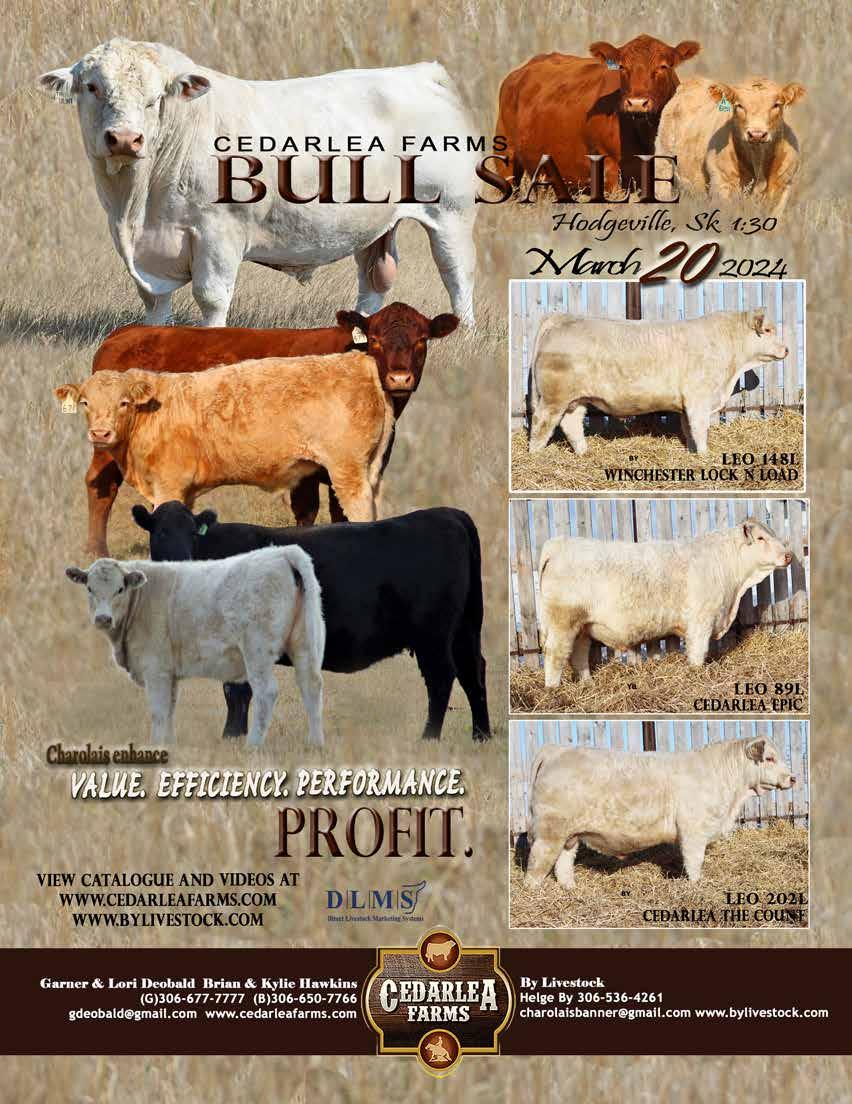
reproductive cycling/ovulation at the start of the breeding season; and therefore, not becoming pregnant early in the first couple of heat cycles.
While weaning weights play an important part in the economics of raising cattle, they pale in comparison to having an efficient breeding program. Every producer strives to wean one live calf for every female (heifers and cows) exposed to the bull. Reproductive performance is by far the most important factor for increasing a cowcalf operation’s bottom line (i.e., profit).
Calving distribution becomes an important driver of reproductive success because it determines the proportion of the herd that will be ready to resume cycling by bull turnout. Reproduction in cattle is somewhat constrained by time, especially the amount of time that it takes for cattle to recover from their previous pregnancy and calving.
Often 60 days post-calving is referenced as the amount of time mature cows need to recover, heifers take longer. However, 60 days is ideal and the amount of time increases if the animal is in poor body condition or receiving inadequate energy. Cattle with lower body condition scores (i.e., <3) and/or those fed low energy diets can take greater than 80 days to recover, which is the beginning of the slippery slope to open cow disasters.
In the first years of poor energy, the calving distributions slowly shift towards more calves born in the second cycle, which may go unnoticed. However, if the low energy situation continues, then more females get bumped into being bred in the second or third cycle. The issue then becomes, if the majority of the cows are bred in the second and third cycle, then a greater percentage have less time to recover for the next breeding.
For those producers who had very poor

pregnancy rates this last fall, it might be of interest to check your calving distributions for 2022 and 2023. This is a fairly simple procedure, just tally the number of head that calved in the first 21 days of the calving season, then the next 21 days, and so on.
Just as poor conception rates may be the result of multiple years of drought, similarly, it may take multiple years to recover. However, according to Matt Makens, a long-range weather forecaster, cattle producers in Western Canada should be prepared for yet another potential year of drought.
Western Canada is currently in a megadrought, which is defined as a drought cycle lasting 20 to 40 years. And, this is no ordinary megadrought, but rather the last 20 years have been the dryest 20 years since the 1100s, which is over 900 years ago. While the Dirty Thirties were awful, they were also relatively shortlived. How long the current cycle will last
is unknown, but forecasters believe it will end between 2025 and 2035. Hence, we may have at least a couple more years of suboptimal rain.
So, what are some strategies to help manage the drought?
Dr. Acton’s advice is, “Next summer, if the amount and quality of pasture is the same as last year, producers need to supplement energy, protein, minerals and vitamins in the same manner that they supplement winter feed in order to have appropriate conception rates. Not an ideal situation to be sure, but both the quality and quantity of forage produced by the pastures last year just did not match the needs of those young growing cows.”
Dr. Klea-Anne Wasilow, Maple Creek Veterinary Services, has a similar view regarding pregnancy rates, “. . . It appears that herds with less robust winter feed/ mineral program have more variability, and I suspect that the cattle are just not as well managed or supplemented through the winter and early spring.”
Dr. Wohlgemuth noted that poor pregnancy rates were particularly evident in their larger herds, which may be related to producers pushing to control their cost of production, resulting in animals that have lower body condition scores going into calving season, and then being placed on suboptimal pastures. She also noted that larger herds tend to utilize swath, bale and corn stover grazing, which makes it more difficult to ensure that the cattle are consuming adequate vitamins and minerals.
Dr. Nathan Erickson has provided some recommendations for consideration:
1) Fortify the winter ration with pellets or better quality forage. Split and feed the low-body and high-body condition groups separately, which reduces competition. If the groups cannot be split, then feed more pellets so all cattle have access, and reduce wastage by using bunks.
2) Increase the amount of pellets (or quality forage) starting two or three weeks prior to calving season, and feed at a higher level until the cattle are moved to grass. If the grass is poor when cattle are placed on pasture, then consider supplementing on pasture.
3) If turning onto stubble before pasture, then consider holding back those with a lower body condition score and first calvers. These females could be kept on a pellet and/or good quality forage ration.
Although, what is fed in the post-calving period is critical, now is the time to ensure that the overwintered cattle are receiving adequate energy, protein, minerals and vitamins. If in doubt, consult a nutritionist or your local veterinarian.
Simply increasing the amount of forage fed might not be sufficient because forage is of low quality and high in fibre, and total fibre limits the amount of feed that cows can consume. Thus, they may be unable to consume enough forage physically, to increase energy appreciably.
Also, as cows move into late gestation, the fetus occupies a greater percentage of the abdomen and this further limits the capacity of the rumen; a lower capacity rumen means that feeding lowquality forage/highly-undigestable forage becomes more risky in terms of the chance of not meeting energy requirements.
Feed the more highly digestable forages towards the end of the last trimester and in the post-calving lactation period. A rule of thumb is to feed the more digestible forages when rumens are at low capacity and when energy demand is reaching its peak. Therefore, increase the protein pellets or find a good quality forage to feed because it is important for late gestation.
Clearly, with the droughts we have experienced, good quality forage is hard and expensive to come by, so the more feasible option is likely pellets. B
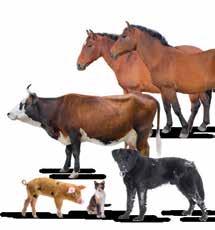

NOTE: If you have any information related to these or any missing livestock file, please contact Livestock Services of Saskatchewan or RCMP Livestock Investigator Cpl. Owen Third at 306-537-9448.


Active Missing Livestock cont. from pg. 44






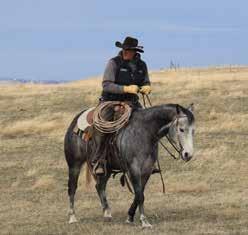 Chief Executive Officer Jason Pollock Livestock Services of Saskatchewan
Chief Executive Officer Jason Pollock Livestock Services of Saskatchewan
Ten years sounds like a long time until you blink and realize that 10 years seems like yesterday.
One of the things that I enjoy about the winter months is the ability to catch my breath from all the busy work on the ranch and dig a little deeper into the numbers from the past year(s). I am always surprised by what I find and what trends over time are indicating.
For most ranchers, winter involves feeding cows and planning for next year. Planning for next year usually involves looking back to see how things went according to the plan, or rather how you managed the changes along the way. Looking back one, two, five and 10 years can produce a mix of feelings from pride to disappointment.
Dwight D. Eisenhower famously said, “In planning for battle, I have found that plans are useless, but planning is indispensable.” In addition to being the 34th President of the United States, Eisenhower owned a small cattle operation, where I am guessing he confirmed this well-known bit of wisdom many times.
Similarly, Helmuth von Moltke, a war strategist in the 19th century, coined the term “no plan survives contact with
the enemy.” He came from the town of Holstein, Germany, and I imagine he may have first learned this lesson through an experience with cattle. That last part has no citation, I am just making some assumptions. At any rate, my plans usually look good on paper, but almost always look very different by the time the dust settles.
The same principle holds true for Livestock Services of Saskatchewan (LSS). Ten years ago, the Saskatchewan government initiated a departure of the provincial brand inspection agency from within the Ministry of Agriculture. LSS was formed and guided by industry representatives, a few of whom still sit on the LSS Board of Directors.
The plan at the time, seemed simple and relatively straight forward. We wanted to provide consistent application of the law with professional services across the province without holding up the speed of commerce. The largest concerns were the declining provincial cow herd, the need to create an administration team to support the field, and replace the wornout central database.
Since those early days:
• A lot of cattle have been looked at (i.e., more than 16 million), and it seems the number of inspections is tied to more than just the provincial cow herd.
• Field teams consistently provide professional service to the industry without affecting the speed of commerce.
• An administration team has been established, complete with an investment in a revenue-generating head office building in Regina.
• Significant improvements to the relationship with the Royal Canadian Mounted Police and ability to investigate and pursue illegal activities have also come to fruition in the decade
since LSS began.
• A lot of effort was put into a revamp of the central database, which houses all the manifest information and data for the organization, and it remains the central hub for decision-making information.
• We enjoy a solid, mutually-beneficial relationship with the Ministry of Agriculture, and have built a strong foundation of trust in our ability to deliver effective legislation through the delegated authority of our Admin Agreement.
• Unexpectedly, we have managed to stretch the initial increase of $0.75 to the inspection fee to implement all these changes and improvements. By any measure, a price freeze lasting a decade is admirable, as LSS has successfully found many efficiencies and continues to pursue improvements in operations, relentlessly.
Through the years, we have said goodbye to many incredible contributors to our organization at the board, manager and inspector levels. Our people are our number-one resource, and our retention rate is high above industry standards by many measures. We have avoided any serious work-related safety incidents, thankfully, and have implemented a full safety program with our staff, which helps keep them safe as well as improve the facilities they work in through identifying issues and working towards solutions.
I am extremely proud of the work and innovation that our inspectors contribute to our industry. The value provided to our industry, in terms of assurance and confidence, translates to willing creditors that invest required cash for operating or capital costs. This is something that we can take for granted at times here in Saskatchewan, but if you have been paying attention to the news in jurisdictions without inspection services, there are continued on page 48
A Decade of Service cont. from pg. 47

Implement on-farm biosecurity practices to minimize, prevent and control animal diseases. Producers are encouraged to follow strict biosecurity standards when managing their cattle. For more information on biosecurity standards and equipment funding opportunities, call the Agriculture Knowledge Centre at 1-866-457-2377.
saskatchewan.ca/livestock
some significant risks to producers there.
LSS continues to provide positive net value on average of $4.00 to $1.00 ratio to Saskatchewan producers, and our aim is to continue to provide this level of service. The past five-year average is a net value of more than $11.6 million contributed back to the industry. This is something we are privileged to provide.
An article celebrating 10 years at LSS would be remiss without acknowledging all the stakeholders that make us successful.
Our owners, the five main livestock groups in Saskatchewan, have been instrumental in providing guidance at the Board level as well as supporting a variety of changes throughout the development of our business model and operations as a private entity.
The dealers and auction markets have been a critical part of our success. We enjoy a very healthy and respect-based relationship with them, and we appreciate all they do for our shared industry.
Cattle producers, transporters, feeders and processors all play an important role in the delivery of our services through their support and compliance with inspection legislation.
We are mindful of our stakeholders and remember the critical importance to remain current and a valuable part of the overall industry.
As mentioned, a look back is important to set the stage for a look ahead. We have much to be thankful for, and are fortunate for the relationships we have within the industry. I have observed the role of LSS move from one of an in-house branch of a large provincial organization, to a valuable player in industry discussions and initiatives. LSS is involved at the provincial, national and international level, and looked to for information and guidance for many regulatory discussions.
Looking ahead, there are some big moves underway for the livestock industry. Cattle numbers are at a low point in the cycle,
inflation has ripped holes in many income statements, profitability continues to be a struggle for all parts of the value chain, and new social trends and “advancements” produce significant challenges for our industry.
LSS will continue to work on its relationship with producers, dealers, transporters,
regulators and financiers to provide a safe and secure environment for commerce.
We are also working on a digital solution (i.e., the MyLivestock Portal), that assists with the mounting paperwork required by legislation, and utilizing our cash reserves to postpone an inevitable request to industry for a fee increase.
As we prepare for the next 10 years, we are keenly aware that our continued success is only possible through the participation and support of our stakeholders. Thank you for your support. B

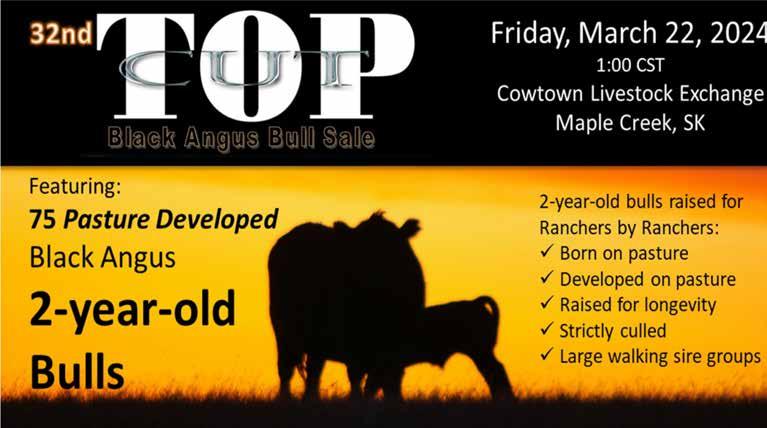
Since February 20, 2022, the Canadian livestock industry has been subject to Canadian Food Inspection Agency’s (CFIA) discretionary power to enforce all humane transport requirements as prescribed in Part XII of the Health of Animals Regulations (HAR) .
The livestock industry is facing new regulatory record keeping pressures with no solution being offered to assist with maintaining compliance. Transporters and receivers of livestock are now required to record information as listed in Part XII of the Health of Animals Regulations, so that documentation for Transfer of Care (TOC) and Animal Transport Records (ATR) can be completed.
The proposed regulatory amendments supporting animal movement reporting as a part of livestock traceability in Canada will further complicate the industry’s efforts to maintain compliance through requirement to report movement records.
A Saskatchewan, industry-led, workinggroup solution to address the issue was developed; however, funding for the project as a national solution was not deemed practical (i.e., if only funded from within Saskatchewan).
Fortunately, our CHIP application innovator SaasyCloud came forward with an offer to participate in the development of an electronic solution, which brought with it revenue potential for enhanced service offerings through the MyLivestock Portal.
With the support of Livestock Services of Saskatchewan’s (LSS) Board of Directors,

LSS agreed to collaborate with SaasyCloud in an arrangement that allowed the project to continue, and for LSS to drive the practical functionality of the new application which aligns with LSS’s strategic objective to remain relevant and a valued service to the Saskatchewan livestock industry.
The MyLivestock Portal is a custom application that provides livestock producers, transporters, and other entities involved in the livestock industry with a means to create and manage the electronic records required for compliance with federal and provincial regulations.
When all the participants have fulfilled their reporting requirements by entering the regulated data for which they are responsible to report, the MyLivestock Portal application will submit all of the information on behalf of all participants to the federal and provincial administrators (e.g., Canadian Cattle Identification Agency, Livestock Services of Saskatchewan, etc.).
For recordkeeping purposes, the MyLivestock Portal application will generate an electronic copy of the livestock movement event for its participants; and each participant will be able to access information related to their role within the event, only.
To participate in this electronic livestock movement reporting application, all regulated parties involved in a livestock movement event (e.g., livestock producers, transporters and other entities) will need to register on the MyLivestock Portal. Once registered, participants will be able to
access the Portal through an application on a desktop computer, tablet or cellular phone; initiate a livestock movement event record; and receive a livestock movement event notification.
The MyLivestock Portal’s purpose is to manage livestock movement event records; however, the platform also offers the opportunity for provincial jurisdictions to administer other online services.
LSS will be the first to capitalize on efficiencies within the electronic platform through a phased approach. Our top priority will be to administer livestock brands and dealer licensing, with subsequent phases that will move our organization into electronic administration of inspection services.
Watch these pages for updates.
B
Sign up to participate in the pilot project with this QR
Code:

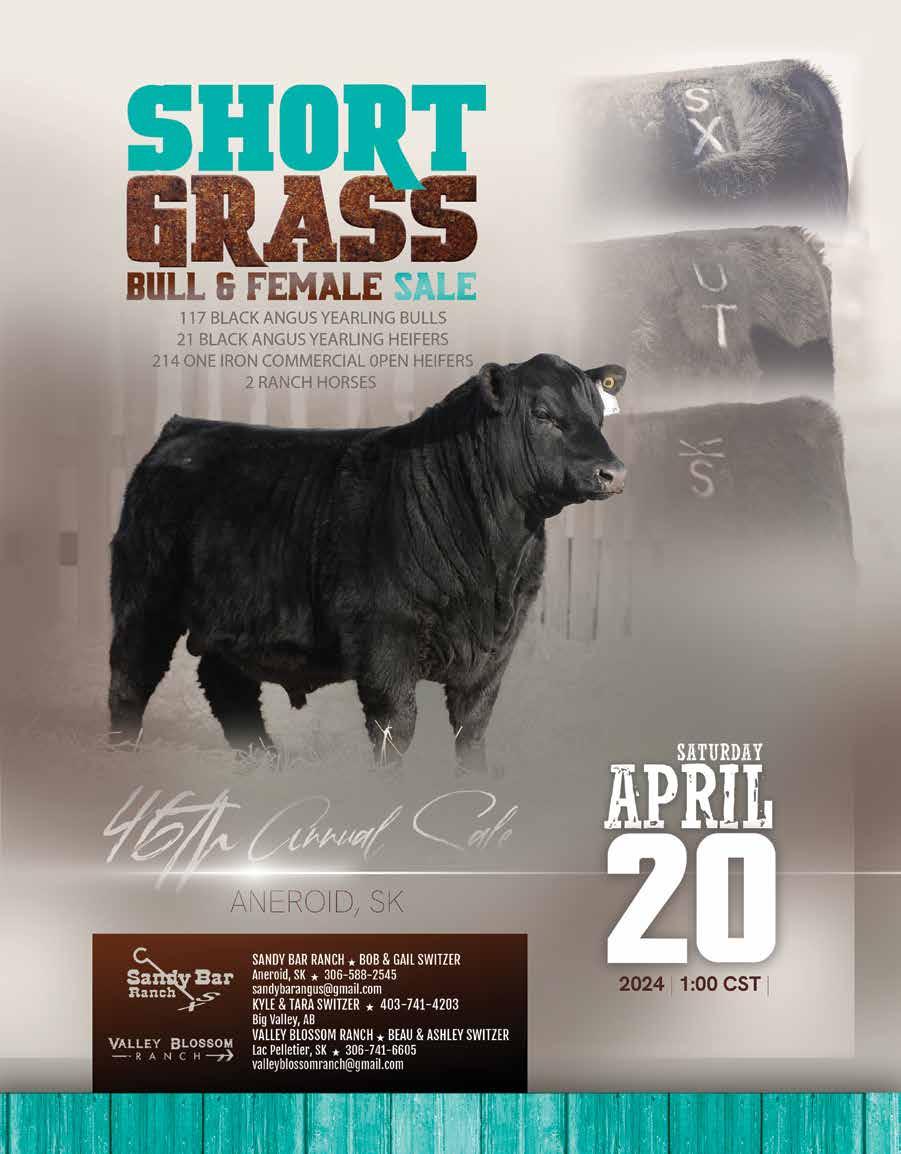
The year 2023 was a very busy for Saskatchewan Angus Association. We spent some time looking at our programming and the future through a formal strategic planning process. Thanks to everyone who provided input. Further outcomes are ongoing, but we do have more focus on education and engagement of our members, youth and producers, in general, and confirmation that our current programs are well received and should be continued.
In June, we had the pleasure of hosting the National Convention at the Sheraton Cavalier in beautiful downtown Saskatoon. Attendance was great and what a pleasure it was to host Angus members from across the country. We look forward to being part of the National Convention 2024 in Toronto.
In July, we saw a huge number of Juniors attend the Canadian Junior Angus Showdown in Swift Current. I’m told it had nearly record attendance with 150 Juniors and 185 head of cattle, second only to Lloydminster numbers in 2017.
I had the personal pleasure of judging the Conformation Show. The quality of cattle was second to none, and the quality of Juniors I saw walk through the ring was outstanding. The young men and women I had the pleasure to work with for the day were hard working, driven, respectful, competitive and polite individuals who
never quit, even in the scorching heat. The parents of all these young members should be very proud, these fine young men and women will shape our future and it was a pleasure to have had the opportunity to be with them in the show ring for the day.
The month of August brought the Saskatchewan Angus Summer Tour. It was hosted by a group of breeders in East Central Saskatchewan. On dayone, the tour saw stops at Parkwood Angus with PK Angus, HS Angus, Dual E Cattle Co., and Double C Red Angus followed by an outstanding Ukrainian meal at Tuffnell Community Hall and entertainment by Quick Dick McDick. Day-two took us to Crescent Creek Angus, Triple H Red Angus with 4K Angus, then to Black Ridge Angus and finally to Nu-Horizon Angus. Supper that evening was held at Dysart Hall where we got to experience exceptional creations from each competitor in the first Annual Verified Beef BBQ Competition. The food and hospitality were amazing and I believe it will be a tour to remember.
We moved our Annual General Meeting from January to host it in conjunction with the Annual Masterpiece Sale. It was held October 20, 2024, at Gold-Bar Livestock in Caronport. Our goal and purpose with moving the date and location was to see a larger attendance and more uptake from our membership. The change was
a positive one and we saw much greater participation than we have seen for many years. The Masterpiece Sale itself was also a huge success, setting a nice tone for the sale season.
November brought us our two Gold Shows, first up at Stockade Roundup in Lloydminster where the Saskatchewan Juniors also hosted their Annual Show. Canadian Western Agribition 2023 saw Angus entries increase. The show and quality of cattle was outstanding. All Angus breeders should be very proud of the quality of cattle being produced as a breed. It is not just one breeder, but the entire breed, coast to coast, working hard to make that happen. The All Star Angus Sale held Friday evening at Canadian Western Agribition was an outstanding event again. The sale grossed $500,450.00 on 26.33 lots for an average of $19,006.83 per lot. Congratulations to all involved.
Looking forward, we will be hosting a Breeder Information Session at the newly opened BoviGen facility in Moose Jaw on Sunday, April 21, 2024—all are invited to attend. July 23, 2024, will see our annual tour hosted in the North Central area of the province and we are excited to be heading back to Prince Albert in August for the 2024 Gold and Junior Show.
Stay tuned to our Facebook page and website for details to come.
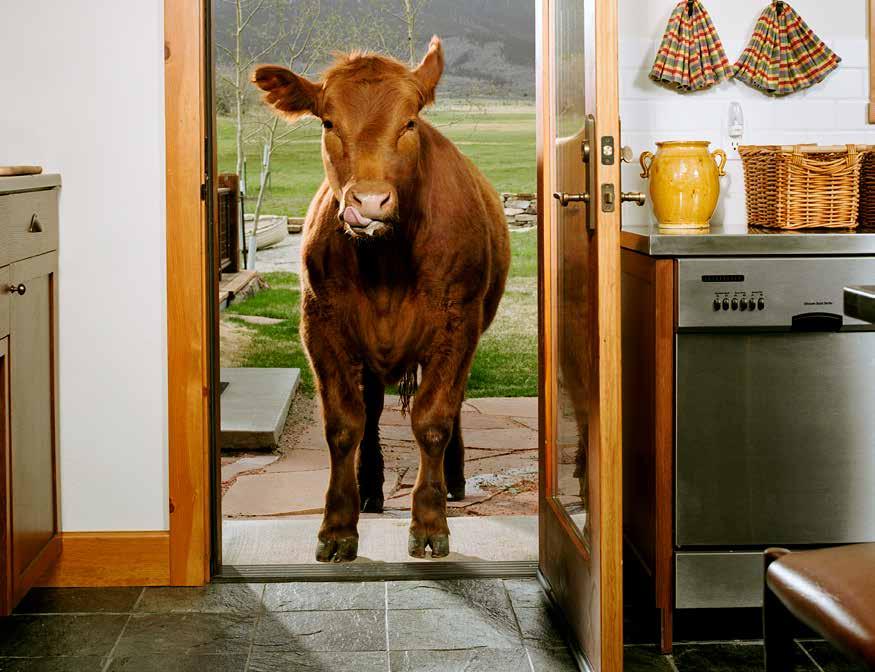
Wherever you go, you feed your family the best. With BrettYoung forages, quality is key. We stand by our products with an industry-leading, 100% establishment guarantee. Choose from one of our carefully crafted stock blends or custom build your own mix for a happy, healthy herd.
To determine the right blend for your farm, visit brettyoung.ca/stock-blend-selector.


the province. Once again, these winners were acknowledged at Canadian Western Agribition (CWA) and will receive wash pants from SCA. Congratulations to these 4-H members!
On behalf of the Saskatchewan Charolais Association (SCA) Board of Directors, I am pleased to provide an annual update. Our board continues to work together to come up with new and innovative ways to support and promote the Charolais breed in Saskatchewan.
The SCA Board remains focused on supporting our youth members. In 2023, we sent out 96 Dairy Queen Gift Cards to 4-H members whom exhibited Charolaisinfluenced calves. With that, there were 10 Charolais-influenced calves that we selected as Grand or Reserve Champion at various 4-H Regional Shows across
Along with the gift cards to 4-H members, SCA continues to sponsor numerous youth shows, including: Mukk Boots or Mittens Jackpot Show, Young Ranchman’s, Junior Stockman’s, Kennedy 4-H Jackpot Show, Canadian Charolais Youth Association (CCYA) Conference & Show, CWA Junior Beef Extreme, Claybank Bricks & Beef Junior Show and the University of Saskatchewan Judging Team. Along with the youth shows, SCA also sponsors industry events such as Livestock Forage Centre of Excellence (LFCE) Field Day, Edam Fall Fair, Lloyd Ex, and Saskatchewan Stock Growers Association Annual General Meeting (AGM) & Convention.
If you know of any 4-H members exhibiting Charolais-influenced calves, make sure to reach out to anyone on the SCA Board. This information can also be found in the Guide for 4-H Achievement Day at 4-h.sk.ca/ achievement-day for clubs to access, which we post online at skcharolais.ca/breederdirectory. Supporting the youth is a main focus of our Board, please reach out to us for sponsorship opportunities!
This summer’s CCYA Conference & Show will take place in Swift Current. If any youth are interested, it would be a great program to check out! You can find more information at youth.charolais.com or watch for entry forms in the May edition of the Charolais Banner.
This past summer, we hosted the Saskatchewan Charolais Association AGM and Sask Royal Charolais Sale on June 18








at Dakota Dunes Resort and Casino. Once again, it was a successful event that brought breeders together from across the province to take part in the AGM, with the sale drawing more of an audience from Alberta and Manitoba than in previous years. Events included a golf tournament, the AGM, a cocktail hour, supper, and the sale.
This year, we had the privilege of hosting our AGM and Sask Royal Charolais Sale in conjunction with the Canadian Charolais Association AGM, Charolais Breeders School, and Charolais Foundation Sale. Our Board is looking forward to working with Canadian Charolais Association and Charolais Foundation Board to plan this exciting event which will take place on June 6 and 7 in Moose Jaw—full details to come this spring.
Every year, Canadian Western Agribition is one of SCA’s main events, and in 2023, our entries remained steady and with another strong CWA Charolais Sale. In conjunction with our Charolais
Show, we recognized the following:
• Saskatchewan Charolais Association
Breeder of the Year was awarded to Layne and Justin Cay, Kinistino, SK
• Commercial Breeder of the Year was awarded to Michael and Shawna Jungman, Duck Lake, SK
• Saskatchewan Charolais Association
Honour Scroll was awarded to Raymond and Betty Paschke, Pine Bluff Stock Farm, Love, SK
• $1,000 Saskatchewan Charolais Association Scholarship was awarded to Halle Herback, Bladworth, SK
Congratulations to all our 2023 award recipients!
Once again, the SCA Board held the $2,000 Charolais Bull Buyer Sale Credit draw for the 2023 bull sale season. All commercial producers that purchased a bull in Saskatchewan in 2023 were eligible. When
we made the draw earlier this year, we selected Tyson Ternes of Maple Creek, SK, as the winner of the Charolais Bull Buyer Sale Credit for 2023.
If you are interested in keeping up with Saskatchewan Charolais Association updates on events, programs, 4-H winners and more, Like and Follow us on Facebook, and visit our website at skcharolais.ca —where you can also view the latest issue of the Saskatchewan Charolais Breeder Directory.
Thank you to all the cattle producers that choose Charolais. After last fall, it is evident the Charolais-cross calves continue to bring a premium—keeping up with our slogan: "No Tag Required."
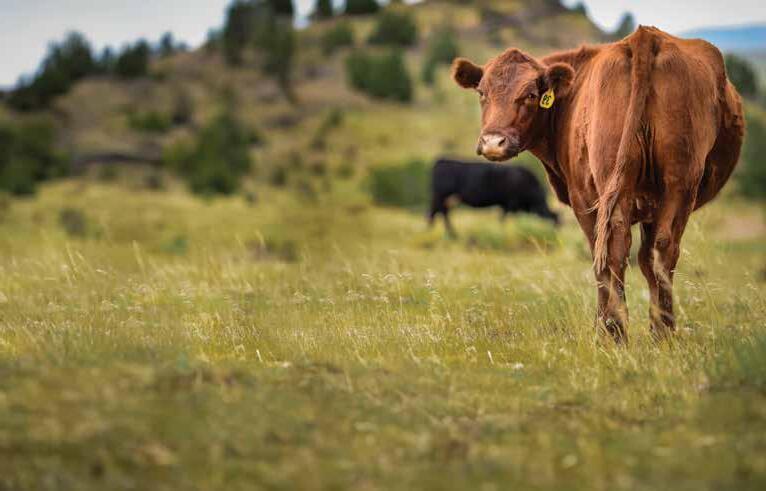


The breeding flock had been stable for a number of years with approximately 60,000 breeding ewes. However, continual drought in parts of the province, escalating production costs and lower lamb prices put pressure on the breeding flock.
Yet, in areas of the province with adequate feed supply, some producers saw the availability of good breeding stock at lower prices as an opportunity to expand. We are anticipating a decrease in the flock size entering 2024, though minimal.
Lamb production in the province is comprised of natural accelerated lambing, synchronized accelerated lambing, semi-confinement lambing, and range grass-based lambing, with production spread throughout the province. Our

Saskatchewan Sheep Development Board (SSDB) data as of December 15, 2023, indicates there are 795 producers registered with SSDB, representing a breeding ewe flock of 59,751 head.
For the most part, the sheep industry has seen steady demand and good prices for the last number of years. However, we experienced weaker prices in 2023. There is a combination of factors at play when it comes to lamb and cull prices.
Food prices and the economy are affecting demand. Lamb is often seen as a specialty protein; when money is tight, it is not the first protein choice. Some producers were forced to sell lambs earlier due to feed or cash flow challenges. An over-supply of light feeders’ lambs being marketed during
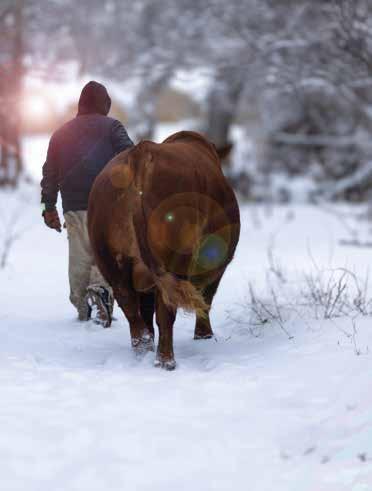

the hot summer when feed conversion is poor, is a formula for weaker prices.
On the cull side, there was a heavy cull, resulting in a surplus of culls on the market. The excess supply of both lambs and culls put downward pressure on prices, added to by panic selling, which increased volumes even further. In December, we saw some rebound in feeder and slaughter prices. We anticipate a further rebound in prices starting in January 2024 as supply becomes tighter.
The lamb industry is unique in that it has three possible revenue streams: meat production, wool production, and targeted grazing contracts. In 2023, we experienced an increase in targeted grazing activities. Sheep provide an environmentally-friendly opportunity to control noxious weeds, brush, and grass residues, which reduced the fuel for fires and grazing management services. The interest and demand for these services is expanding, our challenge is: we have more opportunities than shepherds to do the work.
Research and development project highlights for 2023 include:
• Year-three of the Agricultural Development Fund Ram Evaluation Project, in collaboration with Dr. Dinesh Dadarwal from Western College of Veterinary Medicine (WCVM); and
• The start of the Establishing EvidenceBased Vaccination Schedules for Sheep Producers Project, in collaboration with Dr. Fabienne Uehlinger from WCVM.
This past year was a more challenging year for our producers, though most of us consider this to be a shorter-term situation and remain optimistic about the industry. We continue to see good interest with new producers entering the lamb industry. Sheep are a viable alternative and active part of sustainable agriculture in Saskatchewan with tremendous opportunity for growth.

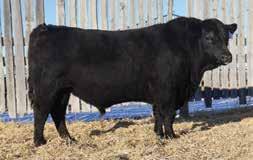



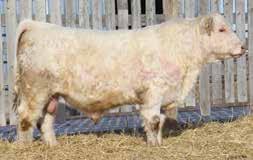
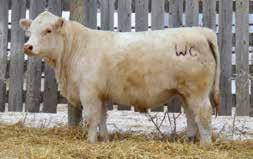


Friends,
We always look forward to our annual update, and during this challenging year that is no different.
Limousin-cross calves continue to be sought after by cattle feeders nationwide. As seedstock producers, we are always encouraged by the positive sale reports and hearing of our clients' continued success. The commercial cow man’s profitability is our number-one focus. Limousin genetics not only provide extra pounds at weaning, but when combined with superior calf vigour at birth, Limousin cattle are in a unique position to increase your bottom line.
On the rail, Limousin cross cattle continue to lead the way. We have always been known for high yield grades. Producers have been able to increase marbling without sacrificing the muscle that the breed has been known for. The results from a Limousin bull and a British-based cow, have become the gold standard for the beef industry. Carcasses that yield, marble


Used with permission from the North American Limousin Foundation
and are in a size range that works for food service (not extreme), is where the industry is moving. The more data that is collected and the continued advancements in carcass measurement technology continue to prove this out.
As you read this, bull sale season will be in full swing. Breeders are spread out across
the province to serve your needs, and look forward to building lasting relationships. Please check our Facebook page for more information and a list of spring bull sales.
This year’s Saskatchewan Limousin Association Annual General Meeting and Field Day will be June 27. Hosted by Double B Cattle Co, outside Unity, SK, the meeting will be in the morning with social activities in the afternoon. Join us as we celebrate the Limousin breed’s success!
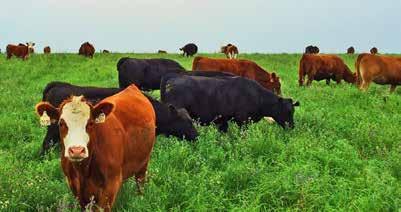
The Saskatchewan Limousin Association Board of Directors would like to thank Saskatchewan Stock Growers Association for the opportunity to provide this update. We are proud to be affiliate members and look forward to the Stock Growers continued success.
2024 Board of Directors:
Ashton Hewson – President
Kyle Payne – Vice President
Jean Hewson – Secretary
Janet Hale – Treasurer
Eric Martens – Past President
Terry Hepner – Director
Jay Bohrson – Director
Jeffrey Yorga – Director
Wyatt Dyck – Director
Andrew Webb – Director
Carrie Hershfield – Director B



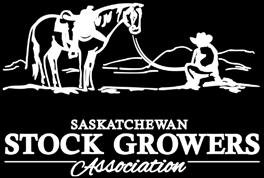
Between now and December 31st, 2024 active Members of the SSGA will receive a $1,250 Young’s Equipment Gift Card for Parts and/ or Service at any Young’s Equipment location with the purchase of any of the following new units:
- Case IH MFD Loader Tractor (60-185 HP)
- Case IH RB565 Round Baler
- NDE Vertical Mixer
- Highline BP60 series Bale Pro®
In addition to that, we will donate $250 per unit sold to the Saskatchewan Stock Growers Association to support their formidable cause.


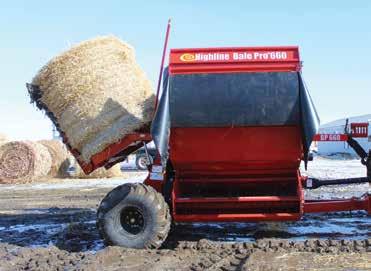

The year 2023 was great! We purchased a new display for our booth. It was seen at Canadian Western Agribition and Ag Days. A new logo was developed and cups were purchased. Cups have been seen at various sales and auction marts. Call a director if you would like some in your area.
Our Annual General Meeting was held in December 2023.
Board of Directors:
President Ian Thackeray, Vice President Braylen Blake, Secretary/Treasurer Cynthia Wirgau, and Directors Maureen Tubman, Eileen Davidson, Brett Spray, Ryan Zalinko and Neil Overby.
Thank you to everyone that volunteered and sponsored our Canadian Western Agribition show, fun auction and donation heifer.
Thirty-five breed tokens were delivered to 4-H members showing Gelbvieh-influenced project animals. We also sponsored six junior shows.
Follow us on Facebook to stay up to date on Gelbvieh events.
Wishing everyone all the best with calving and upcoming bull sales. Hope everyone sees adequate moisture this spring and summer. B
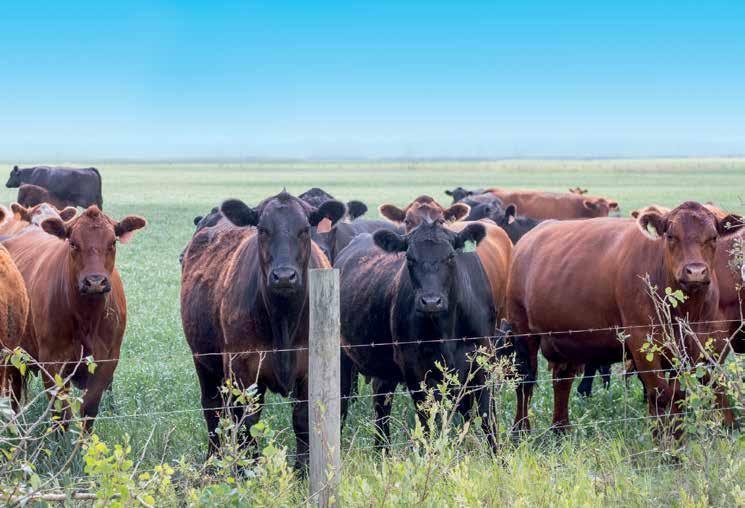
www.dsv-northstar.com
Forage planning plays a crucial role in livestock farming as it involves making informed decisions about forage crops to maximize the efficiency of feed resources. DSV Northstar can optimize your plan with extensive forage expertise, high-quality products and a vast local dealer network.
High performance varieties • Year-round custom blends • Full lineup of stock blends
For additional information or to place an order please contact:
DSV Northstar Ltd. Manitoba / Eastern Saskatchewan • Toll Free: 1-800-430-5955 Alberta / Western Saskatchewan • Toll Free: 1-800-805-0765

We’ve said goodbye to 2023, and here we are amidst another Saskatchewan winter. I hope everyone is keeping well, and that chores and calving are going smoothly for everyone.
Overall, 2023 was a pretty quiet year for Saskatchewan Shorthorn Association. Another Canadian Western Agribition (CWA) has come and gone—this is usually our busiest and most demanding event.
Betty Wyatt returned as our barn boss and we were lucky to have her, as always. However, she has turned in her orange barn boss jacket for the last time, and we can’t thank her enough for her years of guidance and service at what can be a thankless job! She remains an incredible support for myself and the Association and we wish her all the best.
There was another strong showing from
Saskatchewan Shorthorn breeders this past fall. Our CWA show numbers remained consistent with high quality, and our annual banquet was very well attended. It was a great week all around, right down to the mild weather!
In addition to this, sales within the province remained steady once again, with excellent cattle on offer across the board. If you are looking to consign cattle to sales, please consider the Canadian Western Agribition Shorthorn Sale and the Shorthorn Alliance Sale.
Our 2023 award recipients were:
• Glenn Bender – Bender Shorthorns as Saskatchewan Shorthorn Association Honour of the Breed; and
• Jim Martin – Brunthill Farms as Saskatchewan Shorthorn Association Commercial Breeder.
Congratulations to our awardees, once more!
Remember to visit us online! Our website saskshorthorns.com has been updated, and our Facebook page Saskatchewan Shorthorn Association is where you can find updates and information.
We have some exciting events coming up in Saskatchewan:
• Canadian Junior Shorthorn Association National Show and Canadian Shorthorn Association Annual General Meeting –August 2024; and
• Shorthorn World Tour – 2025.
We are looking forward to hosting everyone. Stay tuned for updates! Best wishes to all for 2024! B

 President Garner Deobald Saskatchewan Stock Growers Association
President Garner Deobald Saskatchewan Stock Growers Association
As the seasons change and we roll into full-on calving season, optimism and expectations are at a heightened level. An exceptionally-mild winter has been helpful in getting through the feed challenges brought on by the persistent drought. The lack of snow has made it an easy winter coping with day-to-day chores and travel, but it’s getting down to a crucial time for runoff and spring moisture.
We are now in the period where we need to look at and consider all the business risk management (BRM) tools that are in place to mitigate risk for producers. Coverage through Western Livestock Price Insurance Program (WLPIP) is currently sitting at an all-time high, providing good coverage and value when you consider all of the options. Today as I’m writing this report, WLPIP is at the high end, and you can lock in a price of $392/cwt, the low end can be locked in at $360/cwt with a very affordable premium of $3.03/cwt or $18.18 per 600 pound steer.
Saskatchewan Crop Insurance Corporation has made some changes to their forage and rainfall programming that will improve coverage. We have been asking and advocating for changes in this regard, and feel our input was beneficial in making improvements. Additional weather stations have been added to enhance the coverage and increase density for improved rainfall fall reporting. Adding more weather stations will help in the short term until
satellite imagery can be incorporated into insurance models.
There is an increase coming for the transportation allowance that will provide better compensation. Also, insurance for greenfeed and silage will be available, which has been a longstanding deficiency for many ranchers and farmers. These changes are most welcome, and will definitely factor into the decisionmaking process when we all consider our BRM programs.
In January, we held the Saskatchewan Stock Growers Association (SSGA) Semi-Annual General Meeting (AGM) in conjunction with Saskatchewan Beef Industry Conference in Regina. We had a good turnout for the meeting ,and discussed a number of topics—topics that affect all of us, and which producers debated, resulting in several resolutions.
One resolution deals with wildlife damage to stockpiled forage; one prioritizes animal health and welfare over e-log regulations that hinder animal movement; two are related to compensation for producers affected by a Canadian Food Inspection Agency-imposed quarantine; one addresses Bill C-282, one addresses Bill C-232; and one supports lobbying the provincial government to implement a 2.5-metre setback from the property line in the fencing regulations in the Animal Production Act.
The Semi-AGM agenda also touched on other issues that will be coming forward at SSGA’s Annual General Meeting in June. I encourage all members and all producers to keep an eye out for these important topics that affect what we do each and every day. I also encourage, warmly invite and welcome, everyone to attend and participate in the business SSGA conducts at our AGM in June.
One key concern I have coming out of Saskatchewan Beef Industry Conference
and Saskatchewan Cattlemen’s Association (SCA) AGM in January, is the resolution that was made to increase our check-off levy starting in April 2025.
Currently, we pay a $4.50 levy with $2.00 going to SCA. With the changes coming next year, our overall check-off levy will rise to $6.00 per head with $3.50 going to SCA.
Yes, it is important to have investment in our producer organizations; however, in my opinion, a more reasonable increase would have been in order. SSGA Past President Calvin Knoss asked for an amendment to the resolution for a $0.75 increase instead of $1.50, which would still be a significant increase; unfortunately, Knoss’s request for an amendment was defeated.
As a result, over the next decade, we will pay millions of dollars in additional check-off that comes straight out of producers’ pockets.
I would encourage all members of SCA to attend the fall district meetings to discuss and weigh the merits or the burdens of this change in check-off levy. The fall district meetings are the time to talk about responsible use of our check-off dollars, which is expected and imperative. Again, this is my opinion: I am in favour of a reasonable check-off amount, but an increase of this scale isn’t necessary.
If anyone has any questions or comments on the check-off levy, or any other topic of interest to the livestock industry in Saskatchewan, please email or call me anytime.
Kindest regards,
Garner Deobald gdeobald@gmail.com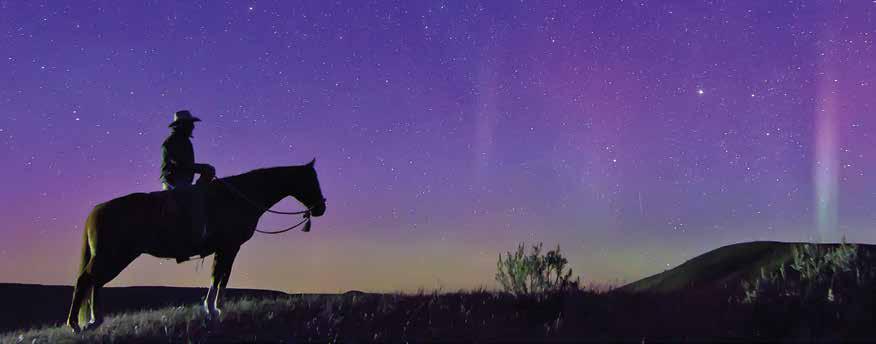
www.DLMS.ca
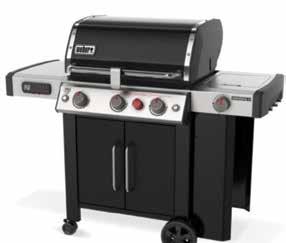
March 25-27, 2024
7 days • South Africa, Limpopo Province
March to October 2024/2025
2 Hunters with 1 PH/Guide • Rifle or Bow



Austin’s Saddlery Barber Motors
Beef Smart
Berglund Ranch Supply
Bovigen
Bullseye Feeds
Canadian Beef Industry Conference
Cedarlea Farms
CJWW (Saskatoon Media Group)
Gateway Veterinary Services
Grain Millers Canada
Greenhawk Regina
J5 Bar Mercantile
Linthicum Ranch
Merck Animal Health
Moose Creek Red Angus
Nahachewsky Charolais
Pearl Snap Photography Performance Seeds
Ponderosa Ag Supplies
Pure Passion Outfitting
Real Agriculture
SK Stock Growers Foundation
STOCKBOSS Energyfree
Livestock Waterers
Titan Livestock Inc.
VBP+
Viterra
Western Cycle
Western Litho Printers
Young’s Equipment
Media Partners:
RealAgriculture
Saskatoon Media Group
Donations as of February 28

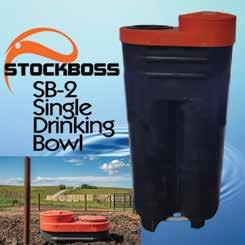
Saskatchewan Stock Growers Association (SSGA) held its semi-annual general meeting January 24 during the Saskatchewan Beef Industry Conference in Regina with opening remarks from Deputy Minister Rick Burton, Saskatchewan Ministry of Agriculture and SSGA President Garner Deobald to SSGA’s board of directors, members and other key industry stakeholders from across the province and beyond its borders.
Inside of four hours, in addition to conducting the required semi-annual general meeting business agenda items, SSGA also hosted two highly-informative presentations and passed seven resolutions.
The first presentation was by Canadian Food Inspection Agency (CFIA) Regional Veterinary Officer Dr. Allison DanylukRoss who provided a situational update
on the ongoing bovine tuberculosis (TB) investigation in Saskatchewan, highlighting critical information related to testing and compensation.
The second presentation was given by Livestock Services of Saskatchewan Chief Executive Officer Jason Pollock, who provided an update on the Livestock Portal Application—MyLivestock—which is an easy-to-use mobile app, designed by SaasyCloudTM.com Inc., that enables producers, transporters and other parties involved in the movement of livestock to comply with Part XII of the Health of Animals Regulations by utilizing one unified platform.
Pollock confirmed, once all the participants in the movement event have entered the regulated data elements into MyLivestock, the app can submit that data on behalf of the reporting parties to LSS and Canadian
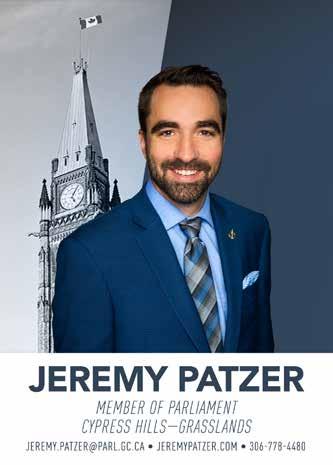
Cattle Identification Agency’s Canadian Livestock Tracking System database. To ensure the app meets industry’s needs, SaasyCloudTM.com Inc. is inviting producers to complete a quick survey at surveymonkey.com/r/JK2SZTL
“We made full use of our time together by carrying seven resolutions, yesterday,” said SSGA President Garner Deobald.
To address the growing problem of wildlife damage, Deobald said SSGA resolved to lobby Saskatchewan Crop Insurance Corporation to put a monetary value on stockpiled forages—similar to the compensation that is currently available for damaged crops and stack damage.
“We also resolved to lobby the federal government to review the Health of Animals Regulations to manage the increasing transportation costs and time in transit to comply with e-log regulations,” Deobald affirmed. “We need to prioritize animal health and welfare in addition to providing flexibility to drivers.”
He also said, “As confirmed by Dr. DanylukRoss in her bovine TB update, considering the tremendous hardship producers experience when their herd is impacted by any reportable disease investigation, we resolved to lobby the federal government to compensate producers for cleaning and disinfecting of the infected premises,” in addition to feed costs and any other expenses incurred as a result of CFIAordered quarantine.
In closing, on behalf SSGA’s board, members and staff, Deobald shared the following: “We established this organization 111 years ago to safeguard the interests of Saskatchewan livestock producers. Our members set policy and direct SSGA’s advocacy efforts. We achieve more by working together. If you are ready to defend and protect our industry by contributing your unique perspective and voice, and you aren’t already a member, contact our office and join SSGA today.” B
Resolution #1
WHEREAS wildlife damage is a growing problem; and
WHEREAS compensation is available for damaged crops and stack damage but no compensation is available for the loss of stockpiled forages;
BE IT RESOLVED that Saskatchewan Stock Growers Association (SSGA) lobby Saskatchewan Crop Insurance Corporation (SCIC) to put a monetary value on stockpiled forages for wildlife damage.
Resolution #2
WHEREAS e-log regulations are hindering animal movement by increasing transportation costs and time in transit; and
WHEREAS animal health and welfare should be the priority;
BE IT RESOLVED that SSGA lobby the federal government to review their regulations to provide flexibility to drivers.

Resolution #3
BE IT RESOLVED that SSGA lobby the federal government to have CFIA include compensation to producers for cleaning and disinfection of any reportable disease.
Resolution #4
BE IT RESOLVED that SSGA lobby the federal and provincial governments to compensate producers for feed costs and any other expenses incurred as a result of Canadian Food Inspection Agency (CFIA) quarantine.
Resolution #5
WHEREAS Bill C-282 has the potential to limit Canada’s participation in future trade agreements; and
WHEREAS limiting our participation in future trade agreements is a threat to our national economy;
BE IT RESOLVED that SSGA lobby the Government of Canada in opposition of Bill C-282.
Resolution #6
WHEREAS Bill C-232 is a very generalized environmental emergency framework; and WHEREAS it has the potential to impact the farming and ranching industry, negatively;.
BE IT RESOLVED that SSGA lobby the Government of Canada to voice concerns over the government being able to call an emergency and make changes without discussion.
Resolution #7
WHEREAS the Government of Saskatchewan is in the process of finalizing the regulations for the Animal Production Act;
BE IT RESOLVED that SSGA lobby the Government of Saskatchewan to implement a 2.5-metre setback from the property line in the fencing regulations.
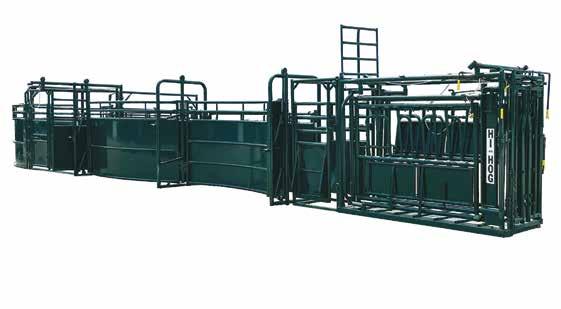
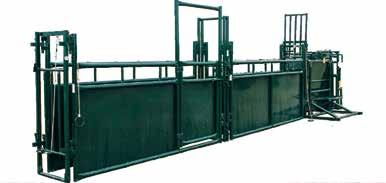


Range managers, researchers and prairie stewards are continuing to improve their understanding and awareness of the complex grassland ecosystem to maintain and improve the state of native prairie pastures.
In 2008, a group of rangeland experts and professionals, led by Saskatchewan Prairie Conservation Action Plan (SK PCAP), developed the Saskatchewan Rangeland Health Assessment. This standardized range assessment concept, originally developed in Alberta, was designed to provide land owners, resource managers and researchers with a repeatable method of checking the functionality of prairie rangeland.
The rangeland health assessment is a fivepoint indicator system that looks at the plant community, vegetation structure, invasive weeds, soil stability and litter cover on a site to determine whether the area is functioning at its ecological potential. Assessors can use a range health assessment to pinpoint specific areas of improvement and help inform management practices.
Sixteen years later, as science and research have evolved and made-inSaskatchewan grassland resources are being developed, range professionals decided to take another look at how the 2008 range assessment tool stacks up. A working group, once again administrated by SK PCAP, is making key updates and improvements to this familiar tool.
The updated assessment will continue to walk users through a series of five questions to focus their observations. The foundation
of rangeland health remains the same— observing a prairie grassland site at a current point in time and comparing it to the potential for that site, known as the “reference community.”
Determining the reference community for the assessment area is based on soils. It takes practice, but is a critical step. The reference community helps assessors determine if what they are seeing is what they should expect to see. For example, when assessing a sandy range site, assessors would expect to find different plants, bare soil, litter and structure than if they were on a clay range site because each rangeland type has a different potential.
When the original rangeland health assessment was developed in 2008, Saskatchewan had yet to finalize the description of a series of reference communities called Saskatchewan Rangeland Ecosystems – Ecosite Guides.
These valuable resources can be found at pcap-sk.org/for-land-managers/ resources and will be incorporated throughout the updated workbook. The revised tool will also address how assessments can be performed even if the reference community is not fully understood.
In the original assessment, Saskatchewan was the first province to adopt a rangeland health score out of 100 points. That proved popular, and since then, Alberta updated their assessment protocol and Manitoba drafted their assessment tool to score out of 100 possible points. While the exact division of points is not yet certain, scoring out of 100 is a nice feature the working group plans to retain.
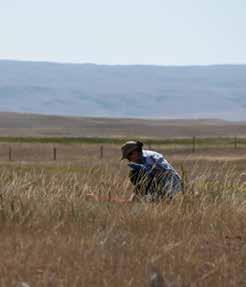
Field staff, ranchers, and researchers have been using the Saskatchewan Rangeland Health Assessment since 2008. The guide is currently being updated to reflect new information and standards.
With the creation and update of rangeland health assessments in Alberta and Manitoba, Saskatchewan’s rangeland health reboot is building off the work of their provincial range counterparts.
As an example, this revamp of the health assessment will include scoring that incorporates woody encroachment. Without disturbance to keep them in check, woody species may naturally replace grassland areas, particularly on moister sites. This is called brush or shrub encroachment, and can result in losses in plant community diversity and reduce available forage and grazing capacity. Manitoba effectively addresses this phenomenon in the 2017 Manitoba Range and Pasture Health Assessment Workbook Draft.
The way that invasive weeds and their abundance are considered will also be modified in the updated version to match the other Prairie provinces. In the original 2008 methods, users classified noxious weeds, like leafy spurge, as the same threat level as agronomic invasive forage species such as smooth brome grass. While neither species is welcome on native grassland

sites, they pose different risks to the overall ecological function and will be scored differently in the updated version.
Litter, the amount of standing or dead plant residue on a range site, is another important measure and tells a story of potential water infiltration, erosion prevention, drought-proofing and soil insulation. Sites with too little litter can have soil loss through erosion and decreased overall production, and sites with too much litter can have reduced biodiversity and stifled productivity. A current University of Saskatchewan study analyzing litter accumulation and productivity on Saskatchewan rangelands will be used to inform the scoring for this updated assessment moving forward.
When the workbook was originally developed, there weren’t smartphones, Google Earth, or broad public access to digital mapping applications or other cloud-based tools. The updated workbook will aim to provide better insight into how to prepare for an assessment and where to find online information and tools. There will also be updated graphics, a decision tree, and other tables that will be shareable on social media.
Building on the past and being accountable to the future
The working group will test drive the
Are you familiar with Saskatchewan’s Range Health Assessment method? What key improvements would you like to see in the reboot? Let us know at pcap@sasktel.net!
updated version this coming summer with the intention to release the new edition in 2025, formally.
For the past 15 years, the Saskatchewan Range Health Assessment has been a go-to assessment method for landowners, students, researchers and other resource managers. With a few practical improvements, the methods will continue to support ranchers, conservation organizations and prairie stewards into the next generation.
Have you seen the 2008 Saskatchewan Range Health Assessment workbook? Find the original version here:

Looking for a better RFID tag? This is it!

Official CCIA tag!

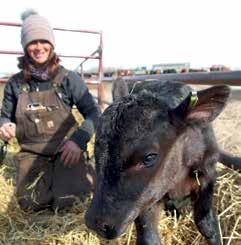
• Stainless steel
• Excellent retention
• CCIA approved tag
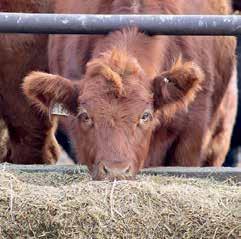
Order now from tags.canada.ca or ask for Shearwell tags wherever you buy your tags.

Depending on where you look, there are a variety of programs to choose from when it comes to working on improving or conserving grasslands in Saskatchewan. One of those groups is Saskatchewan Stock Growers Foundation (SSGF), which was formed to work with Saskatchewan ranchers and landowners to increase long-term sustainable programs that complement our historic and unique ranching landscape.
Short-term programs that may only span one to five years at most, typically, cannot account for the huge environmental role they play. This why SSGF pursues longer terms such as 10 to 15 year agreements or 25-plus year easements, to ensure long-term ranching viability in an already unpredictable industry.
SSGF’s Term Conservation Easement (Term CE) program is the first of its kind, with all other existing conservation easement programs being perpetually tied to the land and affecting landowners for generations—not just for a set-term length. Term CE length is recommended at a minimum of 25 years, but will explore longer lengths depending on landowner operational needs and are tied to land title, while following current legislation that applies to all conservation easements in the province. They have three restrictions and still allow grazing and ranching to resume, for not only the current, but future generations to step in and continue the tradition in their own way.
This structure of using a term length, instead of perpetual easements, brings a flexibility that our ranchers and landowners expressed a need for when they were surveyed about past and current programs. In recent studies completed, perpetual conservation easement payments actually equal out to a Term CE in 55 to 65 years, which truly showcases that the value of a Term CE is not straight forward like a linear relationship to time as previously thought.
With the current use of fair market value for determining landowner compensation, SSGF maintains that evidence from recent studies brought forward from
accomplished agricultural economists, indicates this structure simply isn’t providing enough compensation to the landowners. Landowners know the value of their land and the environmental goods they provide, but have yet to see appropriate compensation through perpetual easement programs in relation to length and restrictions placed on the land title.
SSGF has been exploring additional methods of conservation easement valuation such as an income-based approach.
A study1 put forth by Dr. Jared Carlsberg for Saskatchewan Stock Growers Association and SSGF found that after 50 years, annual cropping systems can make over $500 per acre more than a cowcalf production system. Exploring this type of valuation system can minimize the current discrepancies of income between the two industries.
Agriculture, although widely based on tradition and a way of life, is still a business and differences like that show us why so many landowners are looking to cultivate existing grasslands. When we can account for the differences or part of those differences, it will incentivize more landowners to keep grasslands intact and conserve these disappearing ecosystems.
The current structure of perpetual easement payments only pays the initial landowner for placing land under easement, and it is possible for those payments to be recognized by the federal Eco-Gifts program for tax receipts. Since easements are tied to land title, future landowners still have to abide by the restrictions yet receive no payment. The SSGF Term CEs allow for multiple generations of landowners to make the choice of whether or not the program fits their current needs, by having the option to renew once the term length is up, and to receive payment if renewed. This structure can diversify income while rewarding conservation minded individuals keeping grasslands intact.
In United States, there are multiple programs in place for Term CEs, depending on which state you live in; and they have successfully implemented them for many years now with successful overall uptake. 2 These programs are able to offer payments to landowners that range between 55 to 75 per cent of what they could get for a perpetual easement for a term length of 30 to 35 years.
Similar to SSGF’s Term CEs, the landowner has flexibility to renew the easement once the term length is up or walk away—all while still maintaining control of their land, and continuing to manage it responsibly, as they have been, with access to technical assistance if needed.
SSGF’s goal is long-term grassland conservation that protects our ranching communities. By designing our programs that incentivise keeping grasslands intact by offering not only increased flexibility to next generation, but keeping ranchers on their land and in control of it, we can hope that our research and work goes noticed to increase payments for collaborating ranchers.
Landowners may be hesitant to put land under easement if they have no way out of it, but a term length can let them ease into conservation programs with the flexibility for changes in the future.
The need to conserve and protect grasslands is an increasingly pressing issue—not just in our local communities but on a national level, and SSGF will continue to work with landowners to find programs that fit their growing needs, one step at a time.
Saskatchewan Stock Growers Foundation
1. SSGF Exploring New Approach to Term CE Compensation
https://ssgf.ca/ssgf-exploring-newapproach-to-term-ce-compensation/
2. Learning from Experiences in the United States with Term Conservation Easements
https://ssgf.ca/learning-from-experiencesin-the-united-states-with-termconservation-easements/
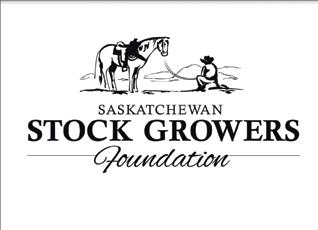
What do Term Conservation Easements mean for your ranch?
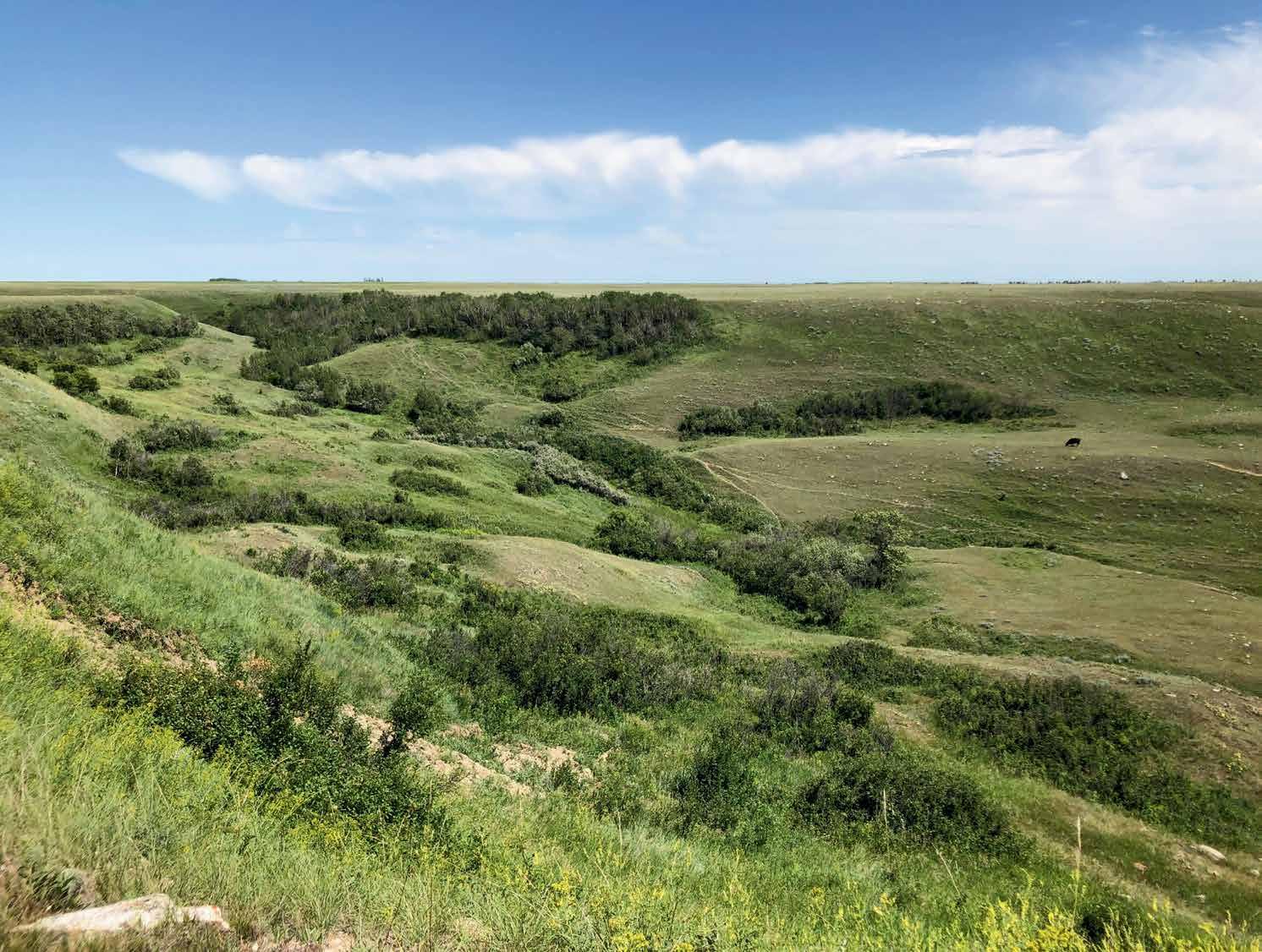
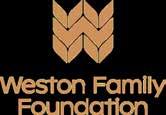











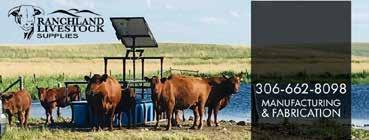

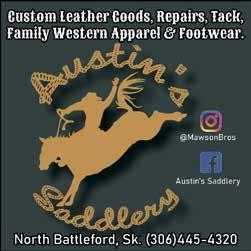

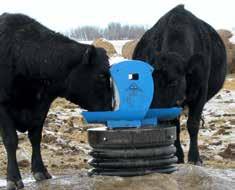






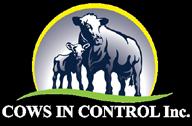






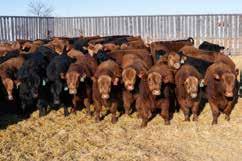





Garner Deobald
President Hodgeville, SK Phone: 306- 677-7777
Jeff Yorga
1st Vice President Flintoft, SK Phone: 306-531-5717
Kelly Williamson
2nd Vice President
Pambrun, SK Phone: 306-582-7774
Chay Anderson
Finance Chair
Fir Mountain, SK Phone: 306-640-7087
Kelcy Elford
Past President Caron, SK Phone: 306-690-5305
Find email contact for the Executive Directors at skstockgrowers.com
Chay Anderson, Fir Mountain, SK 306-640-7087
Keith Day, Lacadena, SK 306-375-2934
Gerry Delorme, Assiniboia, SK 306-640-7493
Calvin Gavelin, McCord, SK 306-478-7748
Adrienne Hanson, Langbank, SK 306-421-8538
Lance Hockley, Yellowgrass, SK 306-891-8189
Joe Gilchrist, Maple Creek, SK 306-662-3986
Kelly Lightfoot, Assiniboia, SK 306-642-8977
Miles McNeil, Alameda, SK 306-489-2073
Lee Sexton, Hanley, SK 306-544-2660
Chris Williamson, Mankota, SK 306-478-7036
Kelly Williamson, Pambrun, SK 306-582-7774
Zone 1 - Henry McCarthy, Wawota, SK 306-739-2205
Zone 2 - Karen McKim, Milestone, SK 306-436-4616
Zone 3 - Larry Flaig, Assiniboia, SK 306-266-2070
Zone 4 - Brad Howe, Empress, AB 306-661-0409
Zone 5 - Aaron Huber, Lipton, SK 306-331-0097
Zone 6 - Dave McKenzie, Delisle, SK 306-493-8127
Zone 7- Darcy Moen, Kyle, SK 306-962-3944
Zone
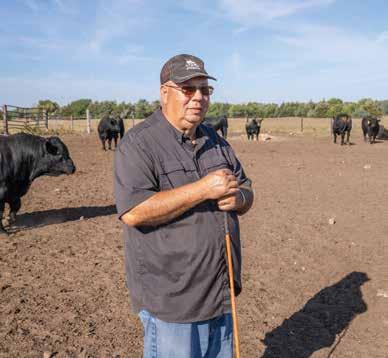
Healthy calves just mean less expense. We just don’t have extra time and labor to put into treating cattle in a pasture setting. We’ve got a man on the place that can rope or do anything that needs to be done. But the fact of it is, he hasn’t used that rope one time this year for treating any of these calves. As they grow and they develop we just have less issues if we can keep them healthier. ENDOVAC-Beef is the product that is making all the difference in the world. We like cattle to look good and to stay sound and have good feet. We’ve enjoyed the results basically no pinkeye and no foot rot issues. I can tell you from an end user standpoint it’s making us money.
- Dan Leo APEX CattleA couple of years ago we had a wreck going and needed a solution. ENDOVACBeef was it! A neighbor recommended the product. I knew it didn’t cost much and I knew what I was doing wasn’t working, so when I found it covered E. coli, Salmonella, Pasteurella, and Mannheimia, I gave it a try. I vaccinated my calves and it worked! Plus, it’s just so easy on them. I give it to my calves around two months of age and again at weaning. The heifers I hold back get it again in June when they go through the chute. It’s just a good product.
The first year we started using ENDOVAC- Beef we had good results. The second year was even better because we implemented it in everything. I vaccinated my cows in April and gave them a booster in June to ensure full protection for my fall calvers and it solved all my scour problems. For those who have spring cows, I would give them a dose in the fall and again in January, about six to seven weeks before they start calving.
Since implementing ENDOVAC-Beef, my medical bill went down and I’m just not treating calves anymore. I haven’t had to doctor one with foot rot either. I can tell you that vaccinating them is cheaper than losing them… it’s worth it. Everything that goes through the chute; cows, calves, and bulls, gets a shot of Endovac at least twice a year now.
- JW Henson Hillview Farms

